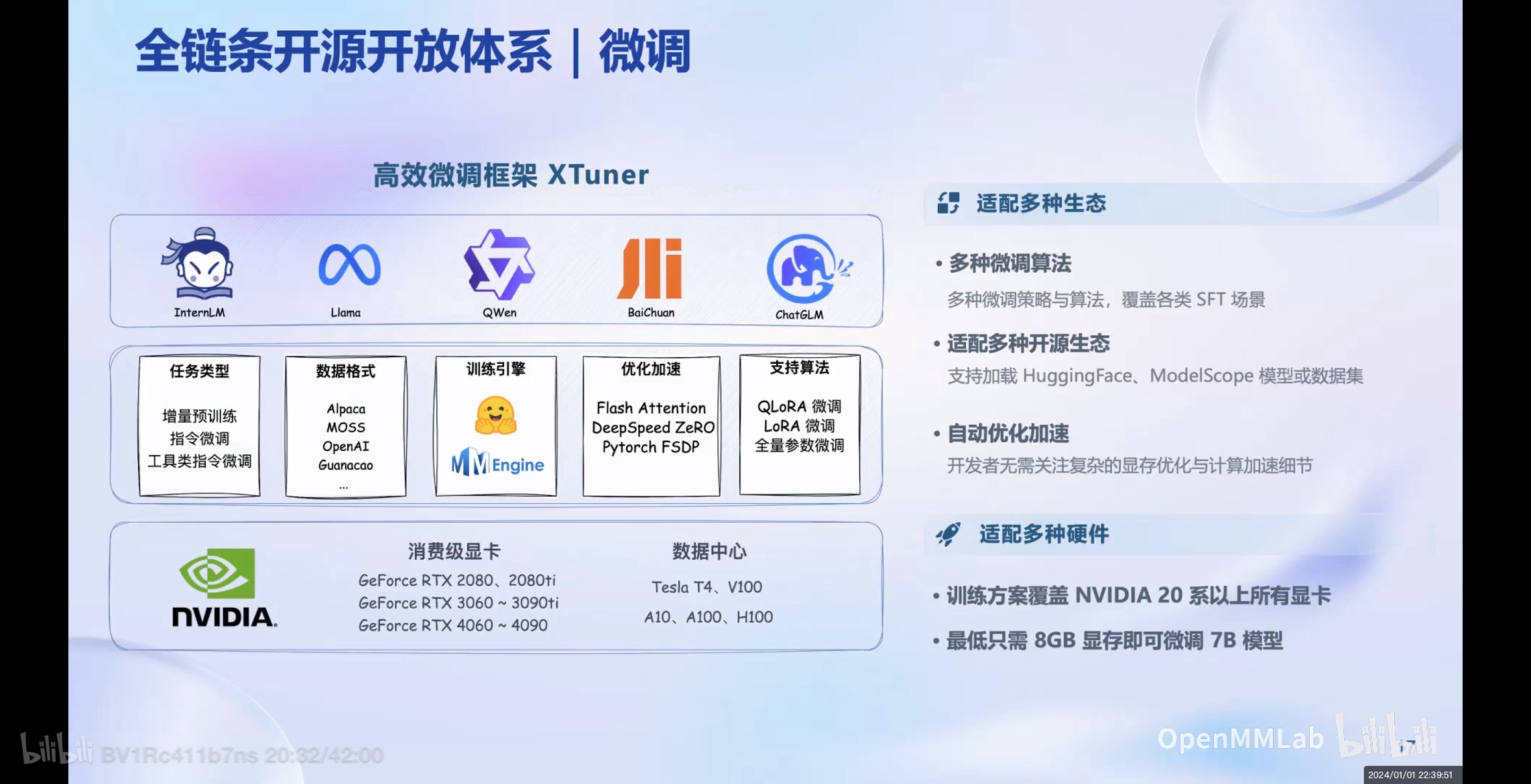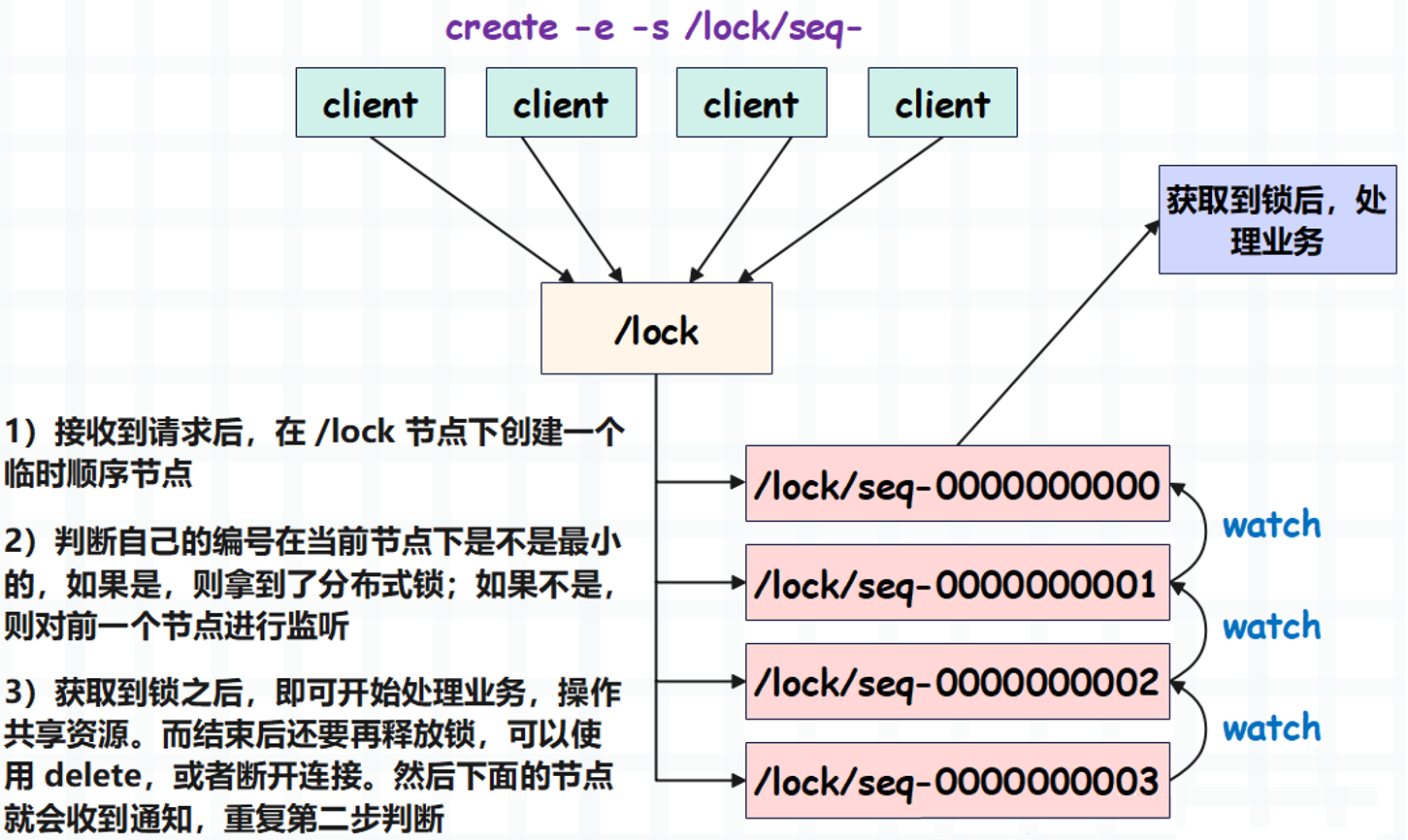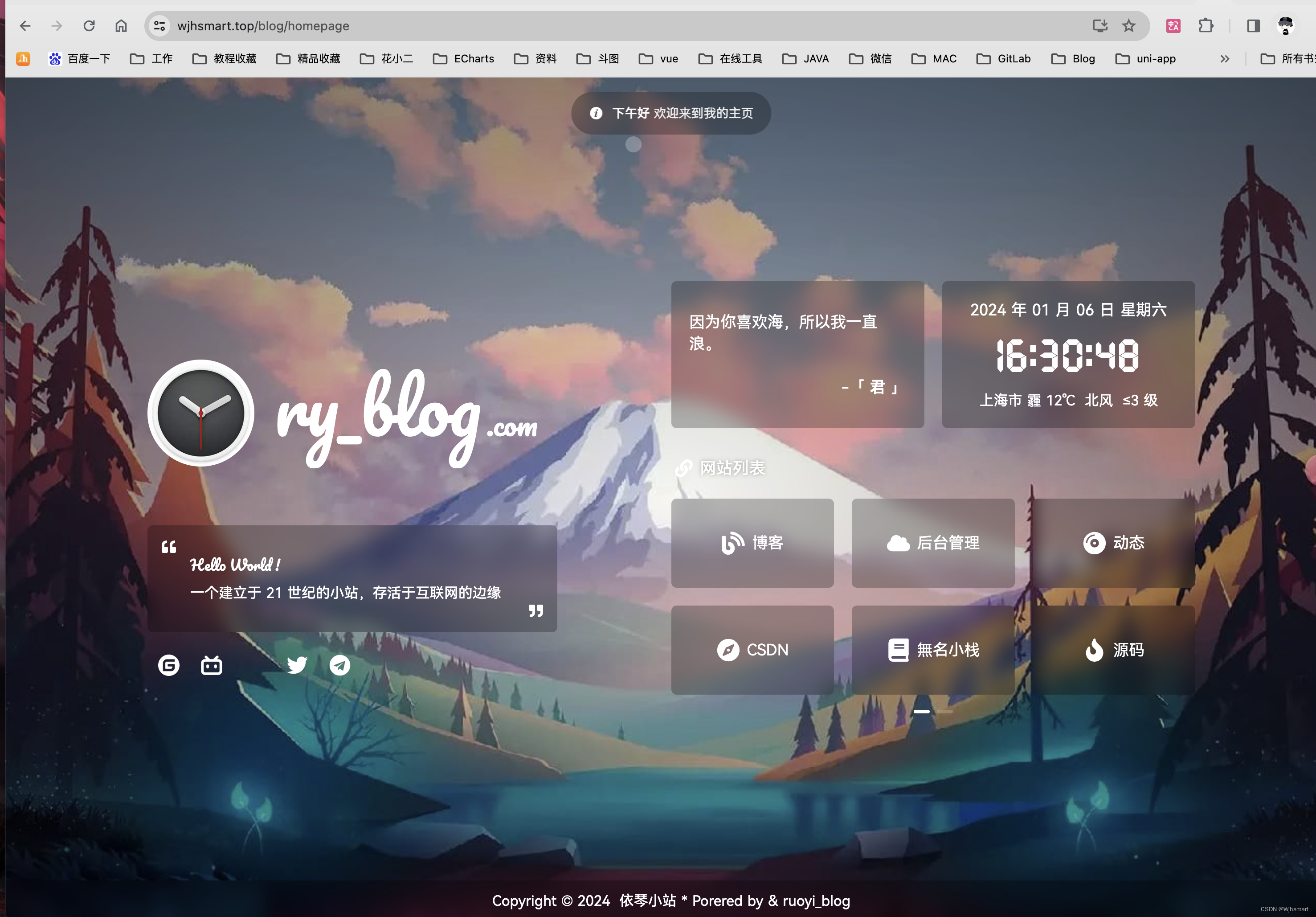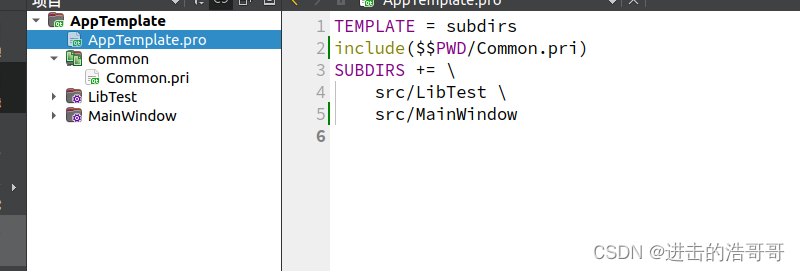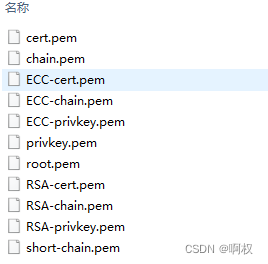12、Shiro
12.1概述
12.1.1简介
Apache Shiro是一个强大且易用的Java安全框架
可以完成身份验证、授权、密码和会话管理
Shiro 不仅可以用在 JavaSE 环境中,也可以用在 JavaEE 环境中
官网: http://shiro.apache.org/
12.1.2 功能
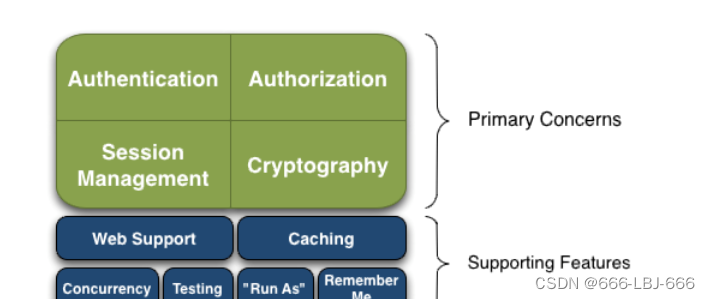
Authentication:身份认证/登录,验证用户是不是拥有相应的身份;
Authorization:授权,即权限验证,验证某个已认证的用户是否拥有某个权限;即判断用户是否能做事情,常见的如:验证某个用户是否拥有某个角色。或者细粒度的验证某个用户对某个资源是否具有某个权限;
Session Manager:会话管理,即用户登录后就是一次会话,在没有退出之前,它的所有信息都在会话中;会话可以是普通JavaSE环境的,也可以是如Web环境的;
Cryptography:加密,保护数据的安全性,如密码加密存储到数据库,而不是明文存储;
Web Support:Web支持,可以非常容易的集成到Web环境;
Caching:**缓存,**比如用户登录后,其用户信息、拥有的角色/权限不必每次去查,这样可以提高效率;
Concurrency:shiro支持多线程应用的并发验证,即如在一个线程中开启另一个线程,能把权限自动传播过去;
Testing:提供测试支持;
Run As:允许一个用户假装为另一个用户(如果他们允许)的身份进行访问;
Remember Me:记住我,这个是非常常见的功能,即一次登录后,下次再来的话不用登录了。
12.1.3从外部看
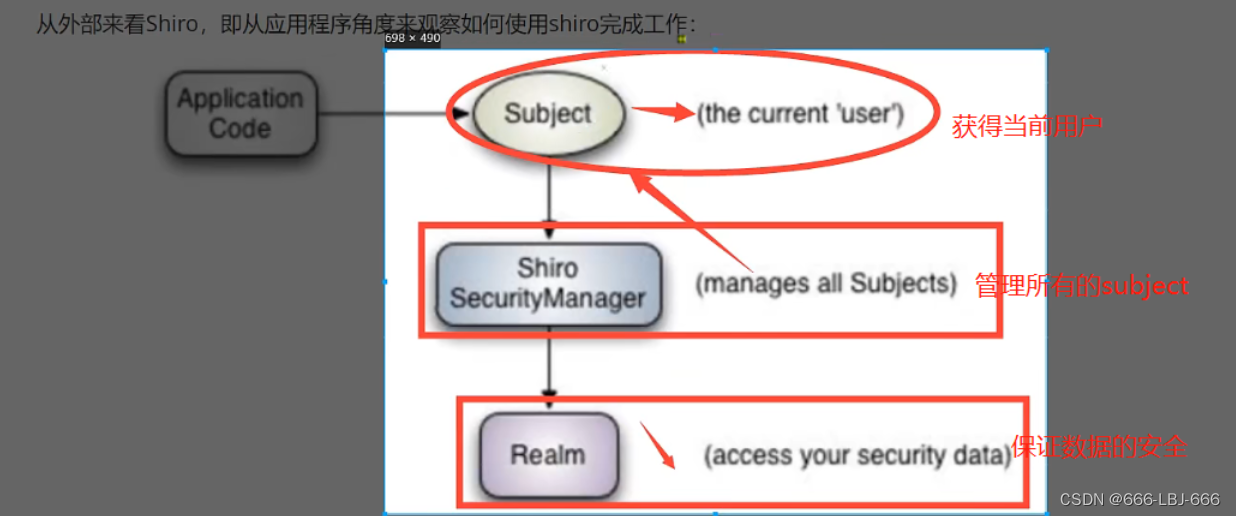
应用代码直接交互的对象是Subject,也就是说Shiro的对外API核心就是Subject;其每个API的含义:
Subject:主体,代表了当前“用户”,这个用户不一定是一个具体的人,与当前应用交互的任何东西都是Subject,如网络爬虫,机器人等;即一个抽象概念;所有Subject都绑定到SecurityManager,与Subject的所有交互都会委托给SecurityManager;可以把Subject认为是一个门面;SecurityManager才是实际的执行者;
SecurityManager:安全管理器;即所有与安全有关的操作都会与SecurityManager交互;且它管理着所有Subject;可以看出它是Shiro的核心,它负责与后边介绍的其他组件进行交互,如果学习过SpringMVC,你可以把它看成DispatcherServlet前端控制器;
Realm:域,Shiro从从Realm获取安全数据(如用户、角色、权限),就是说SecurityManager要验证用户身份,那么它需要从Realm获取相应的用户进行比较以确定用户身份是否合法;也需要从Realm得到用户相应的角色/权限进行验证用户是否能进行操作;可以把Realm看成DataSource,即安全数据源。
也就是说对于我们而言,最简单的一个Shiro应用:
应用代码通过Subject来进行认证和授权,而Subject又委托给SecurityManager;
我们需要给Shiro的SecurityManager注入Realm,从而让SecurityManager能得到合法的用户及其权限进行判断。
从以上也可以看出,Shiro不提供维护用户/权限,而是通过Realm让开发人员自己注入
12.1.4外部架构
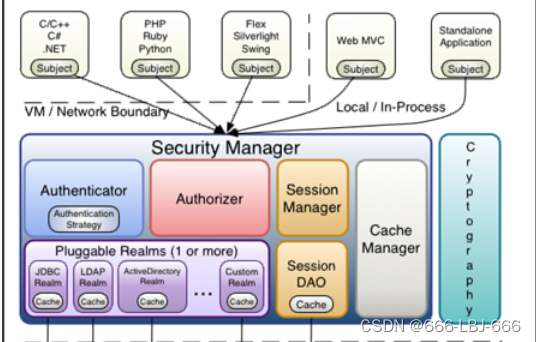
Subject:主体,可以看到主体可以是任何可以与应用交互的“用户”;
SecurityManager:相当于SpringMVC中的DispatcherServlet或者Struts2中的FilterDispatcher;是Shiro的心脏;所有具体的交互都通过SecurityManager进行控制;它管理着所有Subject、且负责进行认证和授权、及会话、缓存的管理。
Authenticator:认证器,负责主体认证的,这是一个扩展点,如果用户觉得Shiro默认的不好,可以自定义实现;其需要认证策略(Authentication Strategy),即什么情况下算用户认证通过了;
Authrizer:授权器,或者访问控制器,用来决定主体是否有权限进行相应的操作;即控制着用户能访问应用中的哪些功能;
Realm:可以有1个或多个Realm,可以认为是安全实体数据源,即用于获取安全实体的;可以是JDBC实现,也可以是LDAP实现,或者内存实现等等;由用户提供;注意:Shiro不知道你的用户/权限存储在哪及以何种格式存储;所以我们一般在应用中都需要实现自己的Realm;
SessionManager:如果写过Servlet就应该知道Session的概念,Session呢需要有人去管理它的生命周期,这个组件就是SessionManager;而Shiro并不仅仅可以用在Web环境,也可以用在如普通的JavaSE环境、EJB等环境;所有呢,Shiro就抽象了一个自己的Session来管理主体与应用之间交互的数据;这样的话,比如我们在Web环境用,刚开始是一台Web服务器;接着又上了台EJB服务器;这时想把两台服务器的会话数据放到一个地方,这个时候就可以实现自己的分布式会话(如把数据放到Memcached服务器);
SessionDAO:DAO大家都用过,数据访问对象,用于会话的CRUD,比如我们想把Session保存到数据库,那么可以实现自己的SessionDAO,通过如JDBC写到数据库;比如想把Session放到Memcached中,可以实现自己的Memcached SessionDAO;另外SessionDAO中可以使用Cache进行缓存,以提高性能;
CacheManager:缓存控制器,来管理如用户、角色、权限等的缓存的;因为这些数据基本上很少去改变,放到缓存中后可以提高访问的性能
Cryptography:密码模块,Shiro提高了一些常见的加密组件用于如密码加密/解密的
12.1.5认证流程

用户 提交 身份信息、凭证信息 封装成 令牌 交由 安全管理器 认证
12.2. 快速入门
将案例拷贝:
按照官网提示找到 快速入门案例
GitHub地址:shiro/samples/quickstart/
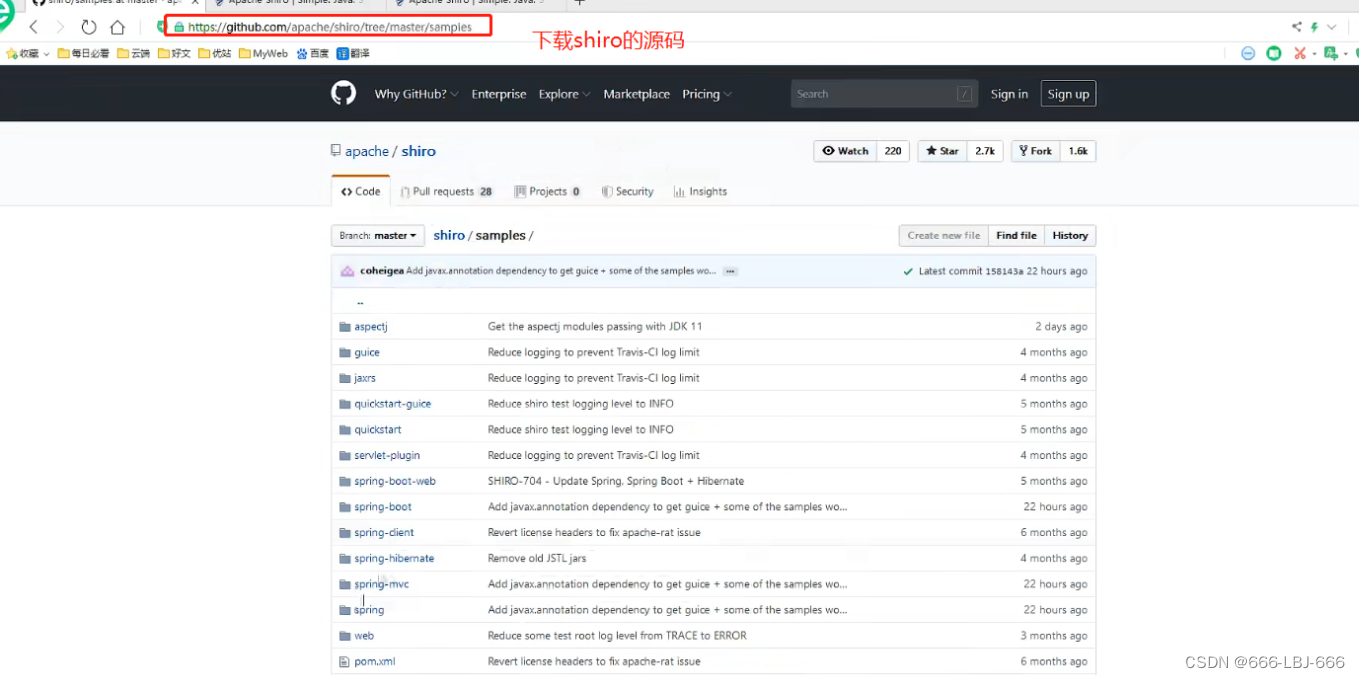
从GitHub 的文件中可以看出这个快速入门案例是一个 Maven 项目
1.新建一个 Maven 工程,删除其 src 目录,将其作为父工程
2.在父工程中新建一个 Maven 模块
3.复制快速入门案例 POM.xml 文件中的依赖 (版本号自选)
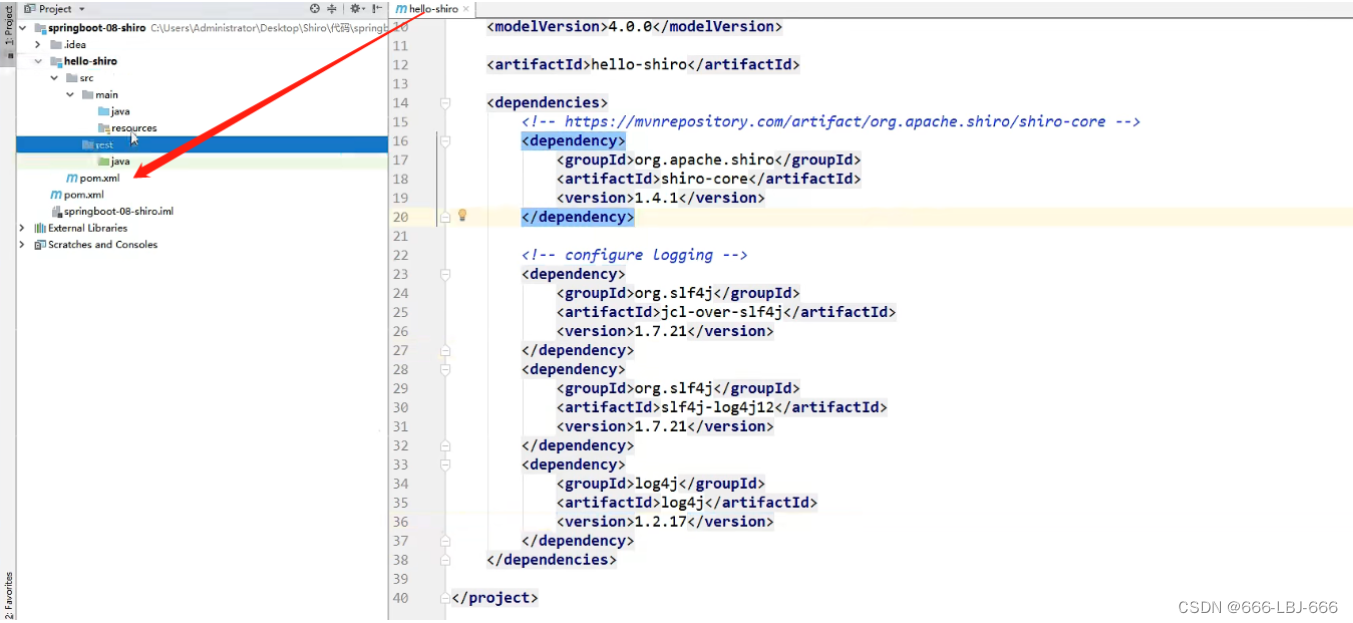
4.把快速入门案例中的 resource 下的log4j.properties 复制下来
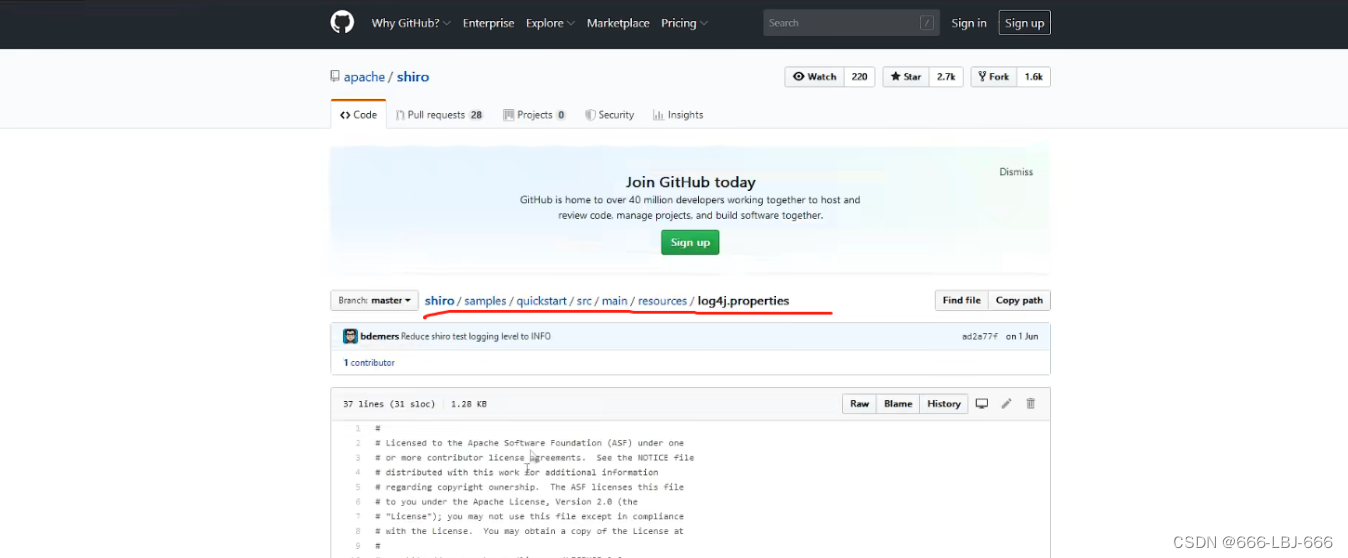

log4j.rootLogger=INFO, stdout
log4j.appender.stdout=org.apache.log4j.ConsoleAppender
log4j.appender.stdout.layout=org.apache.log4j.PatternLayout
log4j.appender.stdout.layout.ConversionPattern=%d %p [%c] - %m %n
# General Apache libraries
log4j.logger.org.apache=WARN
# Spring
log4j.logger.org.springframework=WARN
# Default Shiro logging
log4j.logger.org.apache.shiro=INFO
# Disable verbose logging
log4j.logger.org.apache.shiro.util.ThreadContext=WARN
log4j.logger.org.apache.shiro.cache.ehcache.EhCache=WARN
5、复制一下 shiro.ini 文件
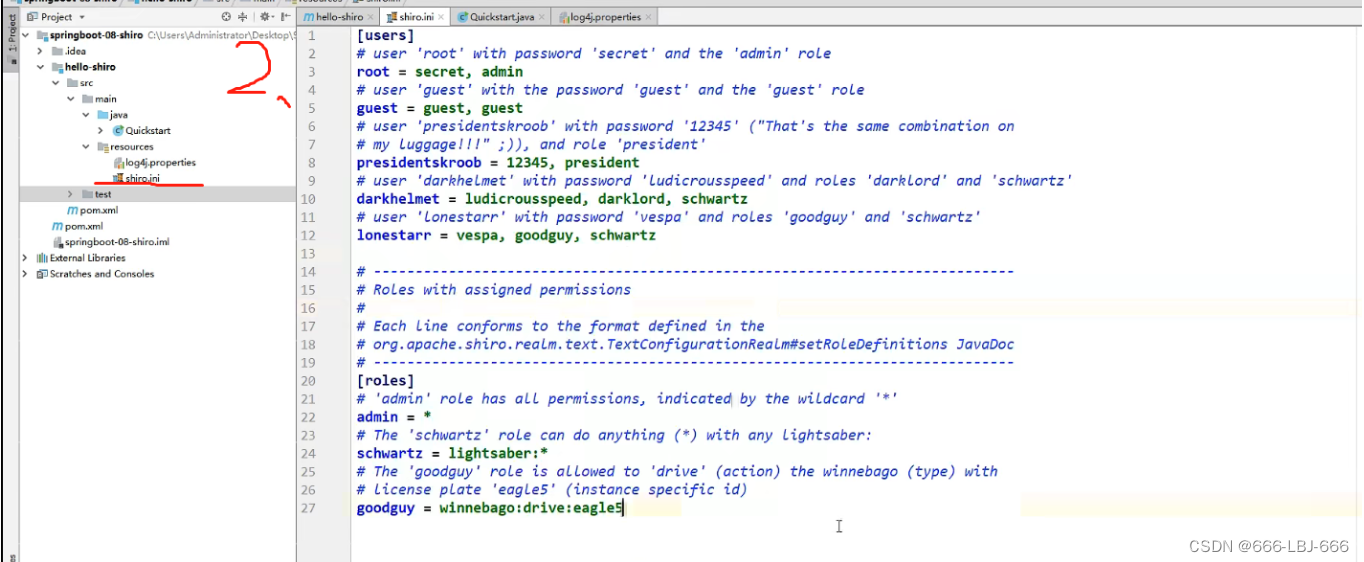
[users]
# user 'root' with password 'secret' and the 'admin' role
root = secret, admin
# user 'guest' with the password 'guest' and the 'guest' role
guest = guest, guest
# user 'presidentskroob' with password '12345' ("That's the same combination on
# my luggage!!!" ;)), and role 'president'
presidentskroob = 12345, president
# user 'darkhelmet' with password 'ludicrousspeed' and roles 'darklord' and 'schwartz'
darkhelmet = ludicrousspeed, darklord, schwartz
# user 'lonestarr' with password 'vespa' and roles 'goodguy' and 'schwartz'
lonestarr = vespa, goodguy, schwartz
# -----------------------------------------------------------------------------
# Roles with assigned permissions
#
# Each line conforms to the format defined in the
# org.apache.shiro.realm.text.TextConfigurationRealm#setRoleDefinitions JavaDoc
# -----------------------------------------------------------------------------
[roles]
# 'admin' role has all permissions, indicated by the wildcard '*'
admin = *
# The 'schwartz' role can do anything (*) with any lightsaber:
schwartz = lightsaber:*
# The 'goodguy' role is allowed to 'drive' (action) the winnebago (type) with
# license plate 'eagle5' (instance specific id)
goodguy = winnebago:drive:eagle5
6、安装插件ini
需要下载ini插件,如果在setting中无法下载,就去官网下载对应版本的然后导入
ini插件安装和配置
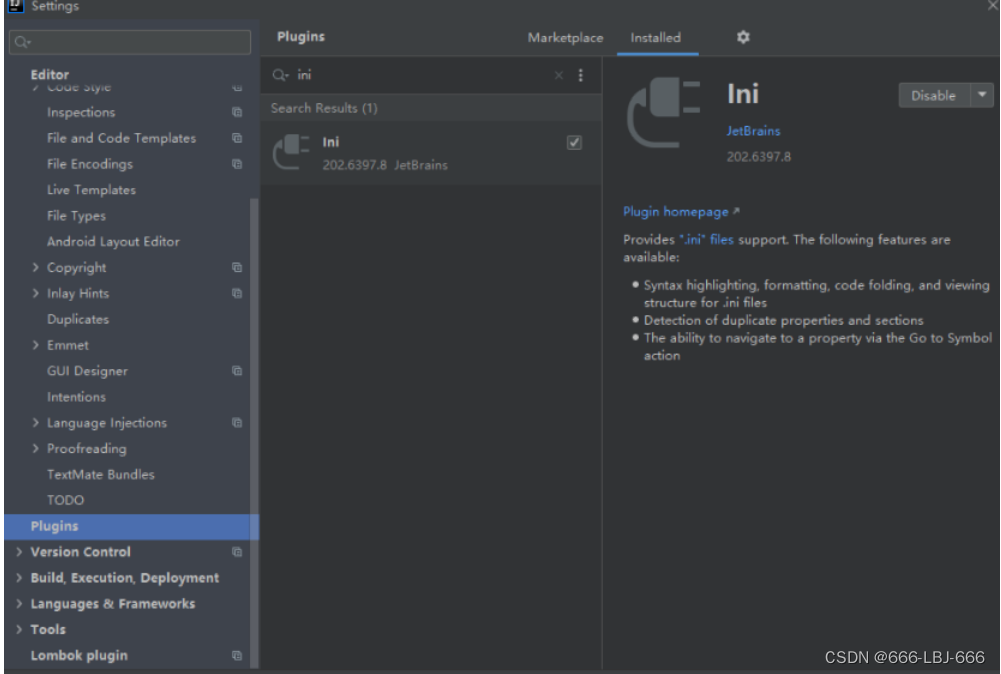
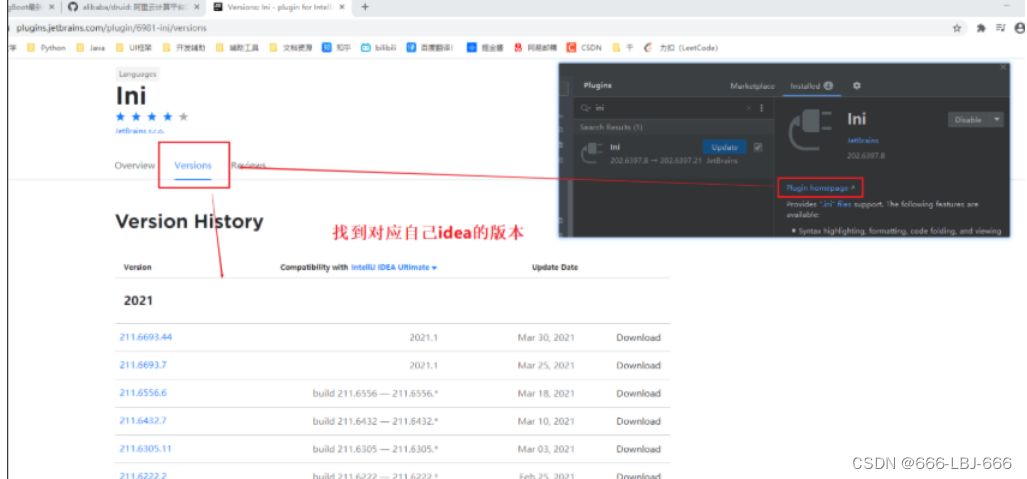
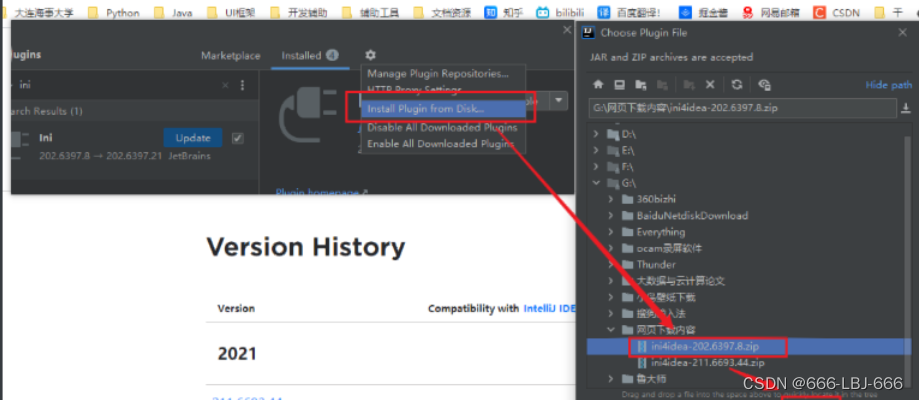
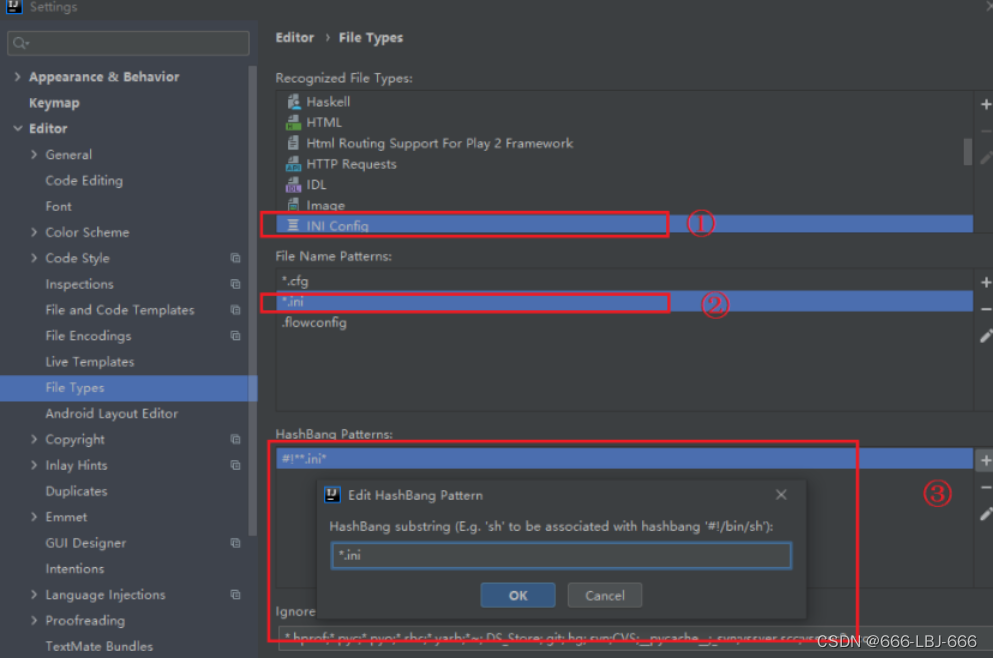
7、导入quickstart.java

import org.apache.shiro.SecurityUtils;
import org.apache.shiro.authc.*;
import org.apache.shiro.config.IniSecurityManagerFactory;
import org.apache.shiro.mgt.DefaultSecurityManager;
import org.apache.shiro.realm.text.IniRealm;
import org.apache.shiro.session.Session;
import org.apache.shiro.subject.Subject;
import org.apache.shiro.util.Factory;
import org.slf4j.Logger;
import org.slf4j.LoggerFactory;
public class Quickstart {
private static final transient Logger log = LoggerFactory.getLogger(Quickstart.class);
public static void main(String[] args) {
// The easiest way to create a Shiro SecurityManager with configured
// realms, users, roles and permissions is to use the simple INI config.
// We'll do that by using a factory that can ingest a .ini file and
// return a SecurityManager instance:
// Use the shiro.ini file at the root of the classpath
// (file: and url: prefixes load from files and urls respectively):
DefaultSecurityManager defaultSecurityManager=new DefaultSecurityManager();
IniRealm iniRealm=new IniRealm("classpath:shiro.ini");
defaultSecurityManager.setRealm(iniRealm);
// for this simple example quickstart, make the SecurityManager
// accessible as a JVM singleton. Most applications wouldn't do this
// and instead rely on their container configuration or web.xml for
// webapps. That is outside the scope of this simple quickstart, so
// we'll just do the bare minimum so you can continue to get a feel
// for things.
SecurityUtils.setSecurityManager(defaultSecurityManager);
// Now that a simple Shiro environment is set up, let's see what you can do:
// get the currently executing user:
Subject currentUser = SecurityUtils.getSubject();
// Do some stuff with a Session (no need for a web or EJB container!!!)
Session session = currentUser.getSession();
session.setAttribute("someKey", "aValue");
String value = (String) session.getAttribute("someKey");
if (value.equals("aValue")) {
log.info("Retrieved the correct value! [" + value + "]");
}
// let's login the current user so we can check against roles and permissions:
if (!currentUser.isAuthenticated()) {
UsernamePasswordToken token = new UsernamePasswordToken("lonestarr", "vespa");
token.setRememberMe(true);
try {
currentUser.login(token);
} catch (UnknownAccountException uae) {
log.info("There is no user with username of " + token.getPrincipal());
} catch (IncorrectCredentialsException ice) {
log.info("Password for account " + token.getPrincipal() + " was incorrect!");
} catch (LockedAccountException lae) {
log.info("The account for username " + token.getPrincipal() + " is locked. " +
"Please contact your administrator to unlock it.");
}
// ... catch more exceptions here (maybe custom ones specific to your application?
catch (AuthenticationException ae) {
//unexpected condition? error?
}
}
//say who they are:
//print their identifying principal (in this case, a username):
log.info("User [" + currentUser.getPrincipal() + "] logged in successfully.");
//test a role:
if (currentUser.hasRole("schwartz")) {
log.info("May the Schwartz be with you!");
} else {
log.info("Hello, mere mortal.");
}
//test a typed permission (not instance-level)
if (currentUser.isPermitted("lightsaber:wield")) {
log.info("You may use a lightsaber ring. Use it wisely.");
} else {
log.info("Sorry, lightsaber rings are for schwartz masters only.");
}
//a (very powerful) Instance Level permission:
if (currentUser.isPermitted("winnebago:drive:eagle5")) {
log.info("You are permitted to 'drive' the winnebago with license plate (id) 'eagle5'. " +
"Here are the keys - have fun!");
} else {
log.info("Sorry, you aren't allowed to drive the 'eagle5' winnebago!");
}
//all done - log out!
currentUser.logout();
System.exit(0);
}
}
8、日志选择
shiro自带的日志:commons-logging
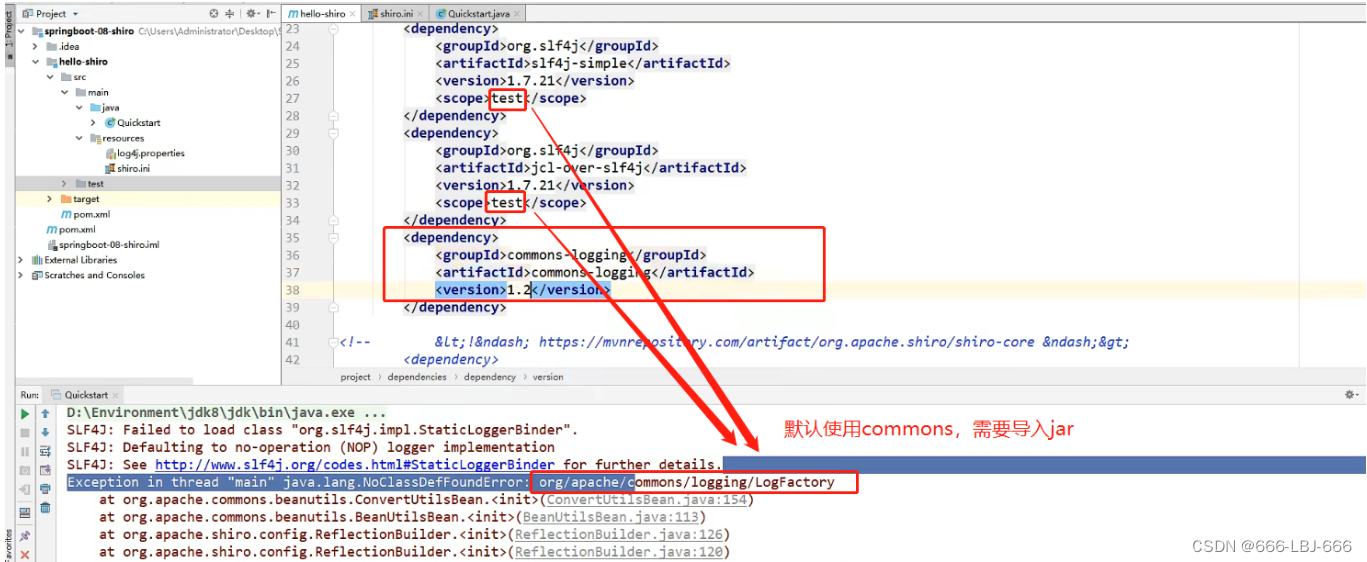
去掉test的运行时

正常日志输出

- 最好还是使用log4j
12.2.2. shiro的分析案例
1.通过 SecurityUtils 获取当前执行的用户 Subject
Subject currentUser = SecurityUtils.getSubject();

2.通过 当前用户拿到 Session,shiro的session
Session session = currentUser.getSession();
3.用 Session 存值取值
session.setAttribute("someKey", "aValue");
String value = (String) session.getAttribute("someKey");
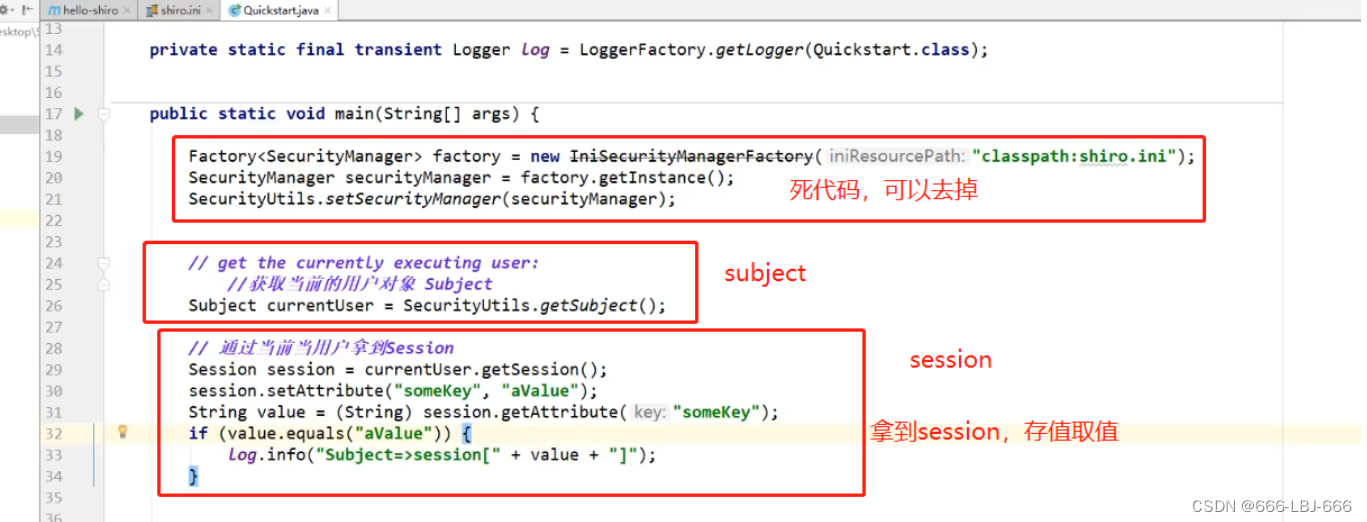
测试:

4.判断用户是否被认证
currentUser.isAuthenticated()
5.执行登录操作
currentUser.login(token);
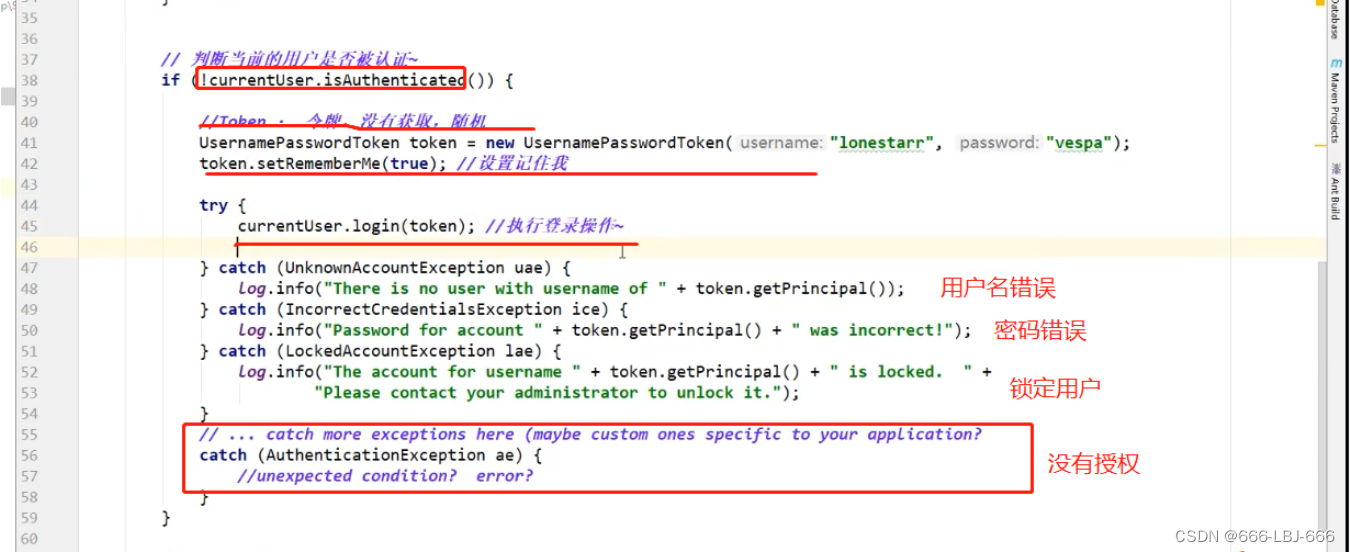
6.打印其标识主体
currentUser.getPrincipal()
7.注销
currentUser.logout();
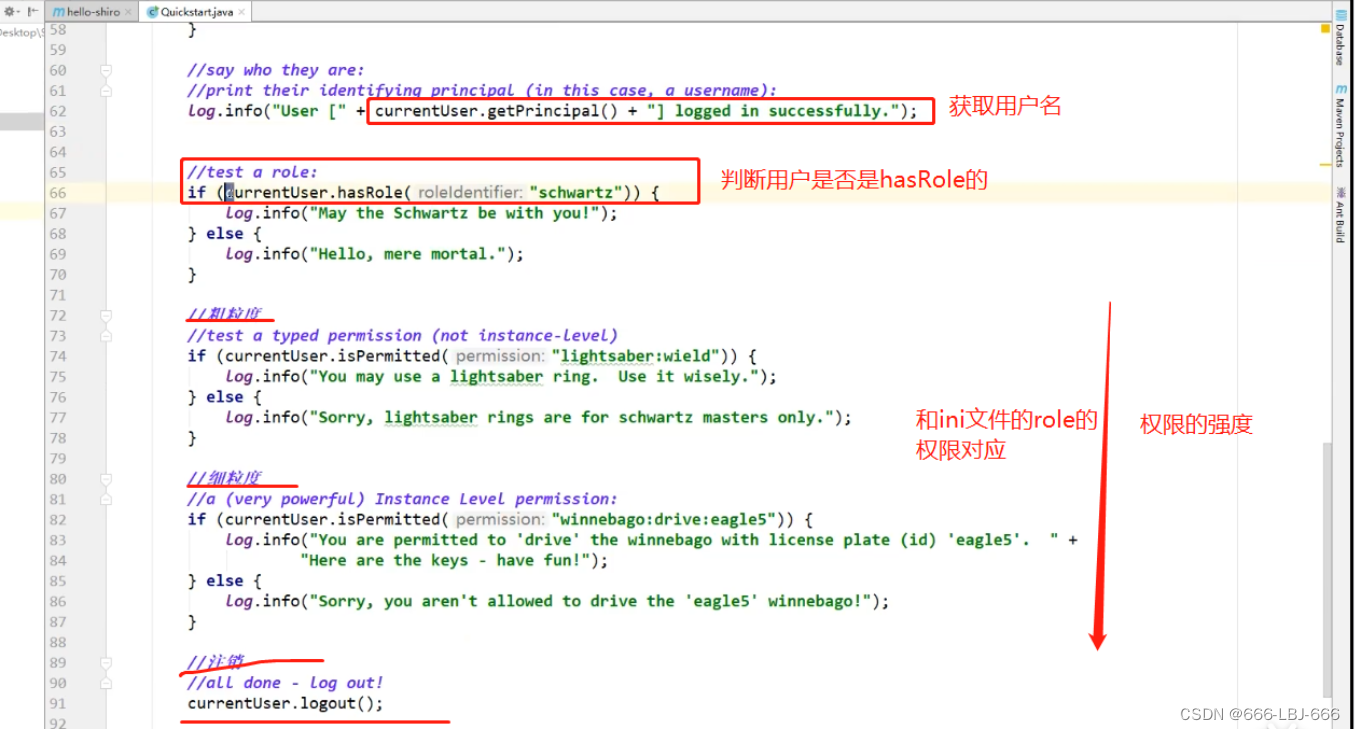
12.3.Springboot集成Shiro
1、SpringBoot整合Shiro环境搭建
下面是编写配置文件
Shiro 三大要素
subject -> ShiroFilterFactoryBean ----当前用户
securityManager -> DefaultWebSecurityManager ----管理所有用户
Realm
实际操作中对象创建的顺序 : realm -> securityManager -> subject ----连接数据
①引入thymeleaf模板引擎和SpringBoot-shiro的集成jar
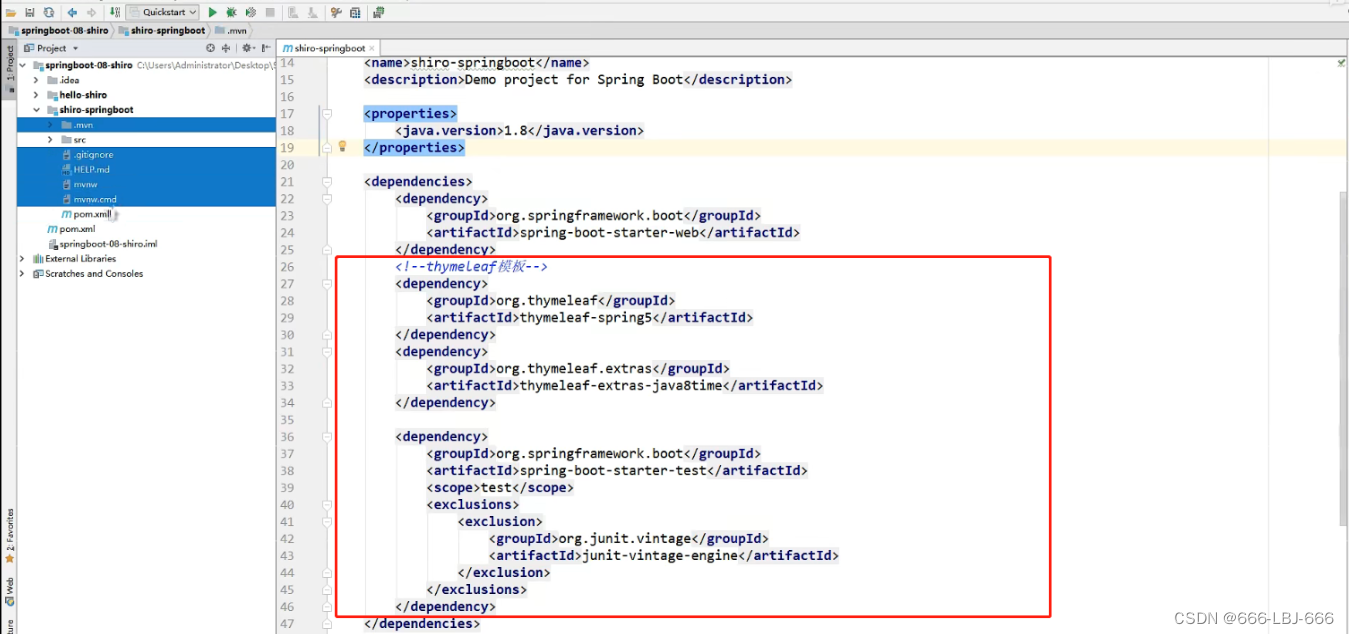
<!--thymeleaf模板引擎-->
<dependency>
<groupId>org.thymeleaf</groupId>
<artifactId>thymeleaf-spring5</artifactId>
</dependency>
<dependency>
<groupId>org.thymeleaf.extras</groupId>
<artifactId>thymeleaf-extras-java8time</artifactId>
</dependency>
<dependency>
<groupId>org.springframework.boot</groupId>
<artifactId>spring-boot-starter-test</artifactId>
<scope>test</scope>
<exclusions>
<exclusion>
<groupId>org.junit.vintage</groupId>
<artifactId>junit-vintage-engine</artifactId>
</exclusion>
</exclusions>
</dependency>
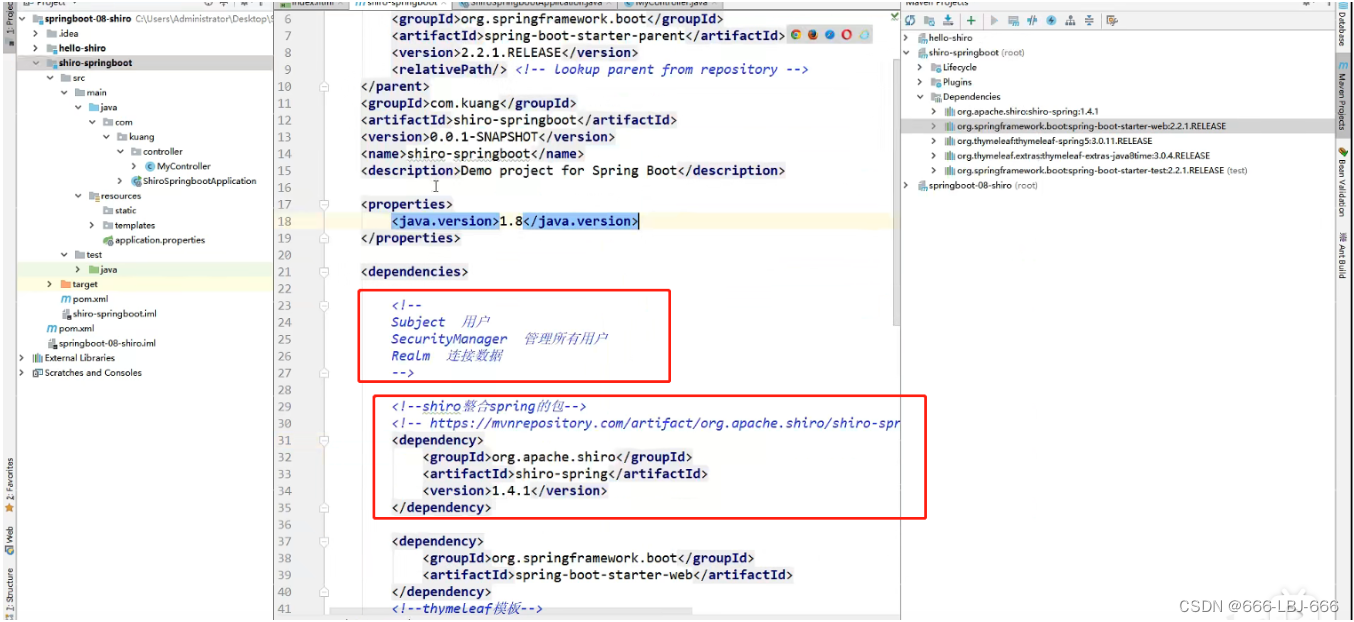
<!--SpringBoot 和 Shiro 整合包-->
<!-- https://mvnrepository.com/artifact/org.apache.shiro/shiro-spring-boot-web-starter -->
<dependency>
<groupId>org.apache.shiro</groupId>
<artifactId>shiro-spring-boot-web-starter</artifactId>
<version>1.6.0</version>
</dependency>
②自定义UserRealm类(1)

public class UserRealm extends AuthorizingRealm {
//授权
@Override
protected AuthorizationInfo doGetAuthorizationInfo(PrincipalCollection principalCollection) {
System.out.println("执行了授权方法");
return null;
}
//认证
@Override
protected AuthenticationInfo doGetAuthenticationInfo(AuthenticationToken authenticationToken) throws AuthenticationException {
System.out.println("执行了认证方法");
return null;
}
}
②创建ShiroConfig配置三个元素
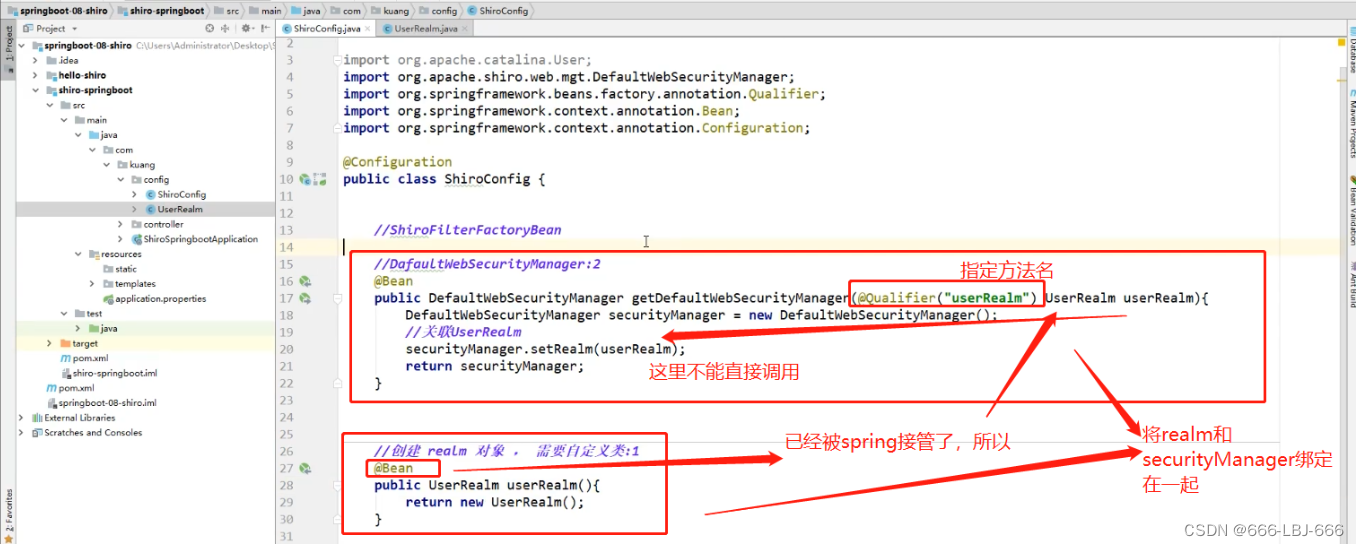
三个元素都需要作为spring的bean被spring托管

点击查看源码,发现securityManager是ShiroFilterFactoryBean的属性

按照1-3的顺序,设置构建Shiro的三要素
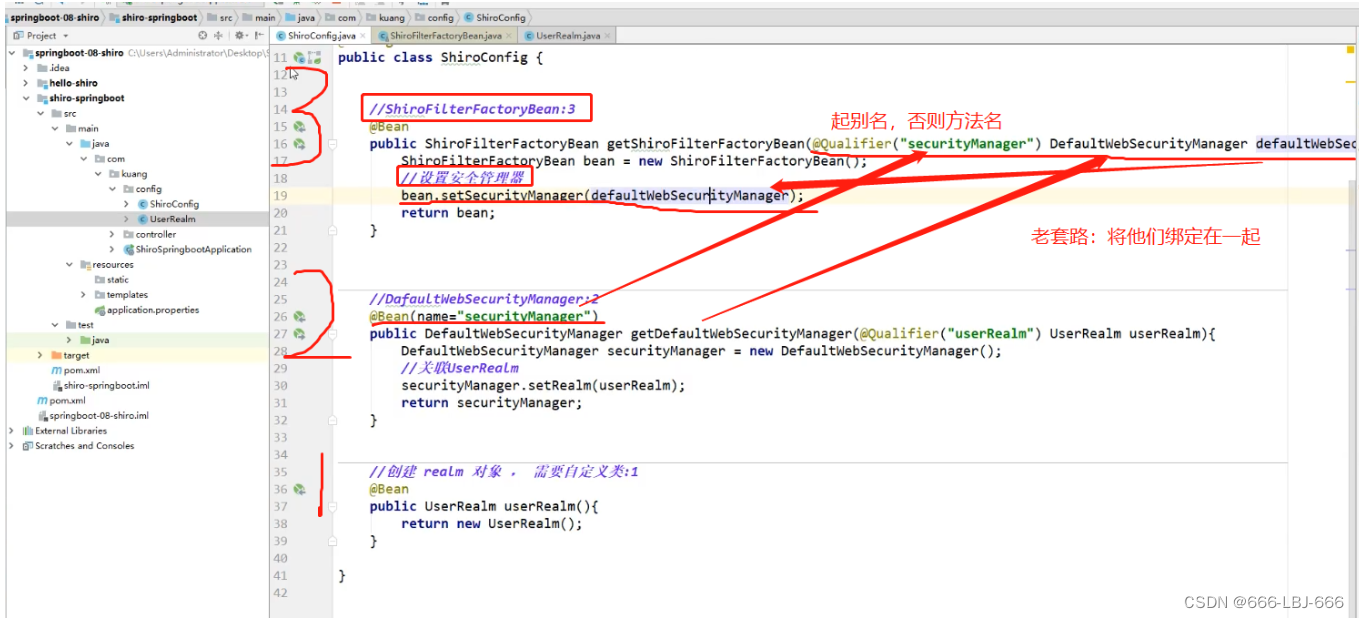
<1>根据前面提供的顺序,先编写realm类:
//1:创建realm对象,需要自定义
@Bean(name = "userRealm")
public UserRealm userRealm(){
return new UserRealm();
}
<2>创建用户管理,这里需要用到前面创建的realm,因此在realm之后进行编写
//2:创建管理用户需要用到
@Bean
public DefaultWebSecurityManager defaultWebSecurityManager(@Qualifier("userRealm") UserRealm userRealm){
DefaultWebSecurityManager securityManager = new DefaultWebSecurityManager();
securityManager.setRealm(userRealm);
return securityManager;
}
<3> 创建subject,需要传入一个securityManager,因此最后进行编写(是不是很像套娃)
@Bean
public ShiroFilterFactoryBean shiroFilterFactoryBean(@Qualifier("defaultWebSecurityManager") DefaultWebSecurityManager securityManager){
ShiroFilterFactoryBean subject = new ShiroFilterFactoryBean();
//设置安全管理器
bean.setSecurityManager(securityManager);
return subject;
}
③首页、add、update页面和controller
thymeleaf的命名空间
xmlns:th="http://www.thymeleaf.org"

update页面
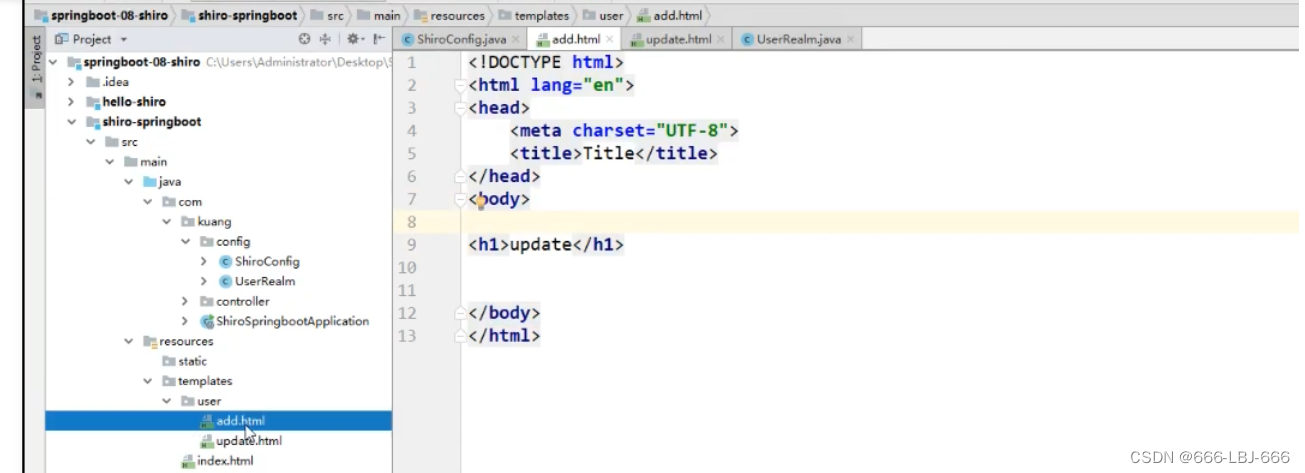
add页面
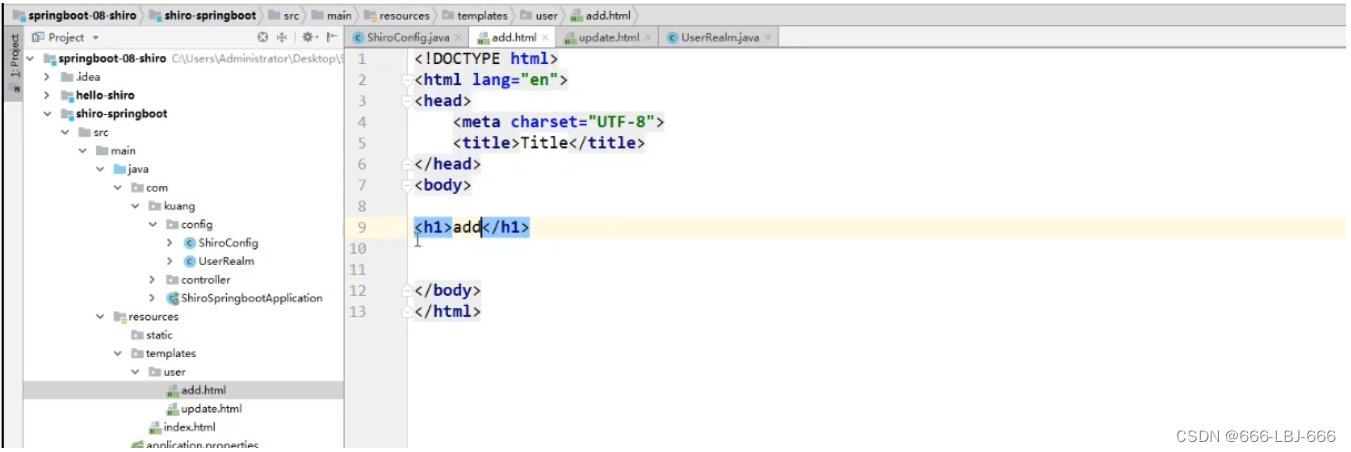
设置controller
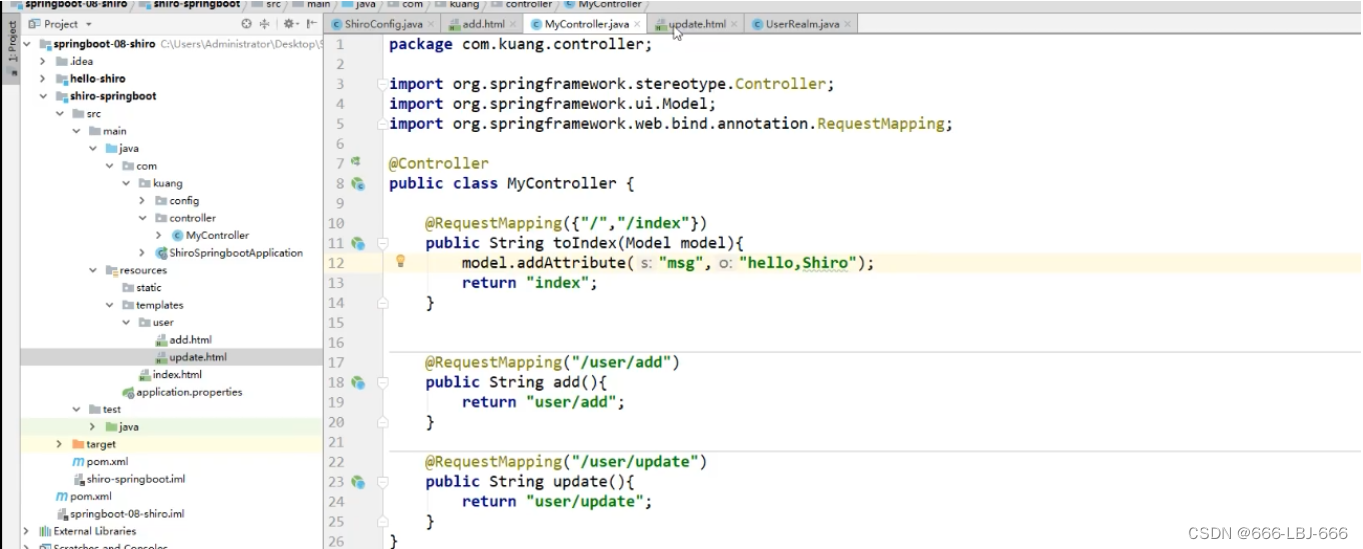
测试:正常跳转访问页面
2、shiro实现登录拦截
①在ShiroFilterFactoryBean中添加shiro的内置过滤器
将拦截信息存放在map中

测试:
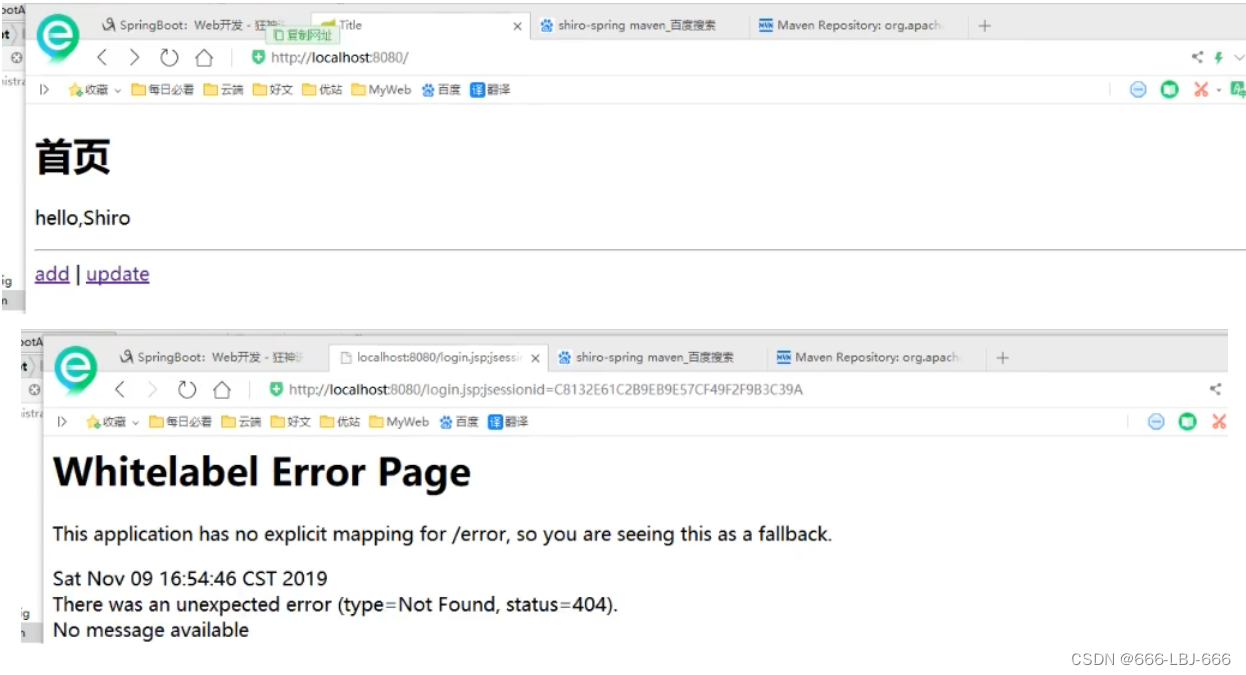
②无查看权限跳转到login页面
设置controller

login页面
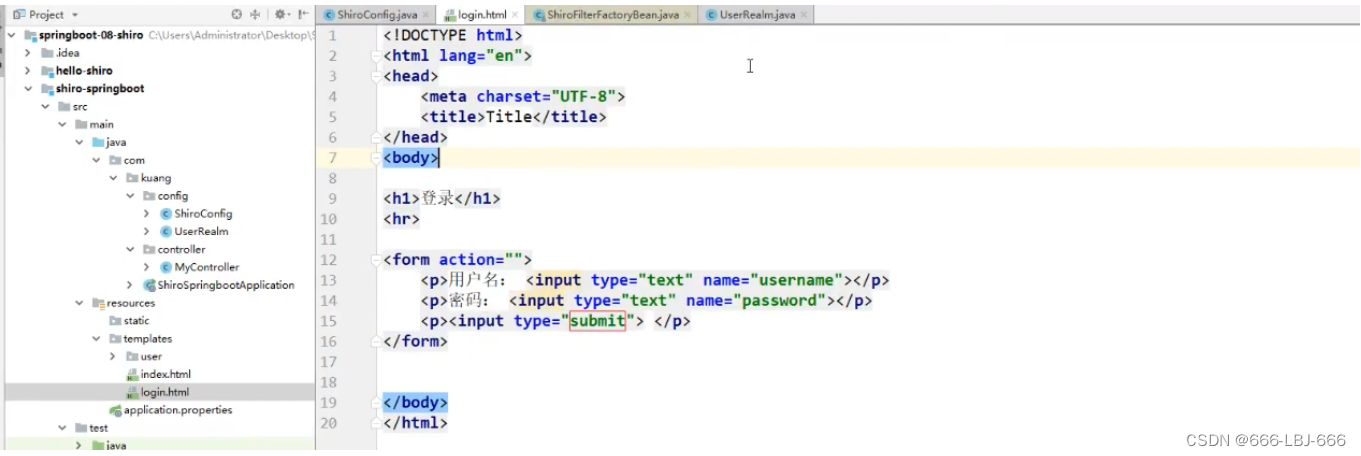
设置登录的请求

测试:
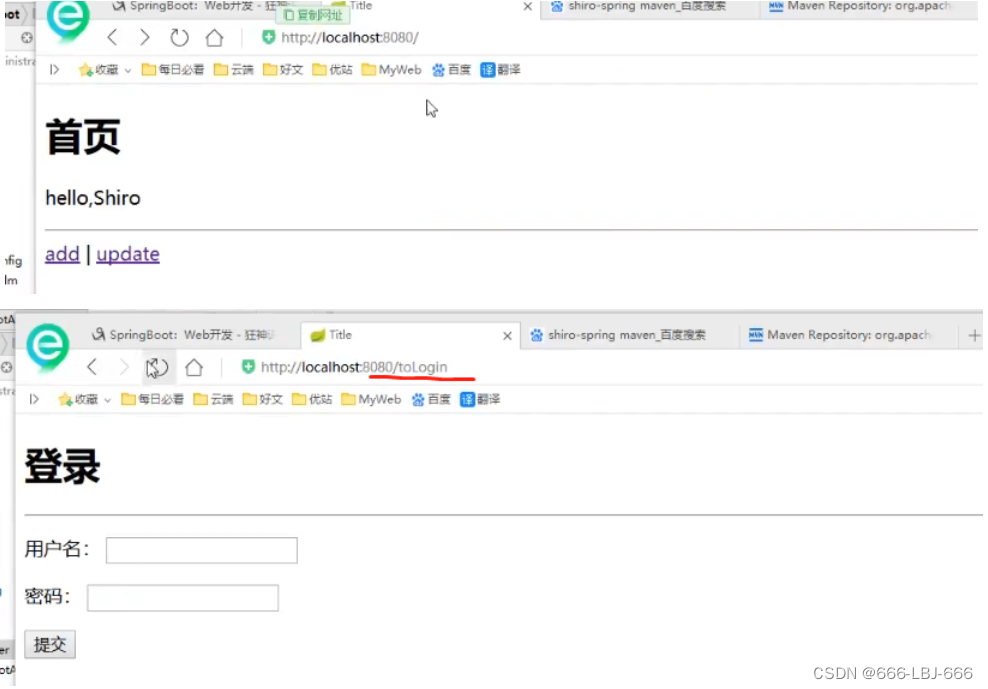
3、Shiro实现登录认证
①在controller中封装前端数据生成一个令牌
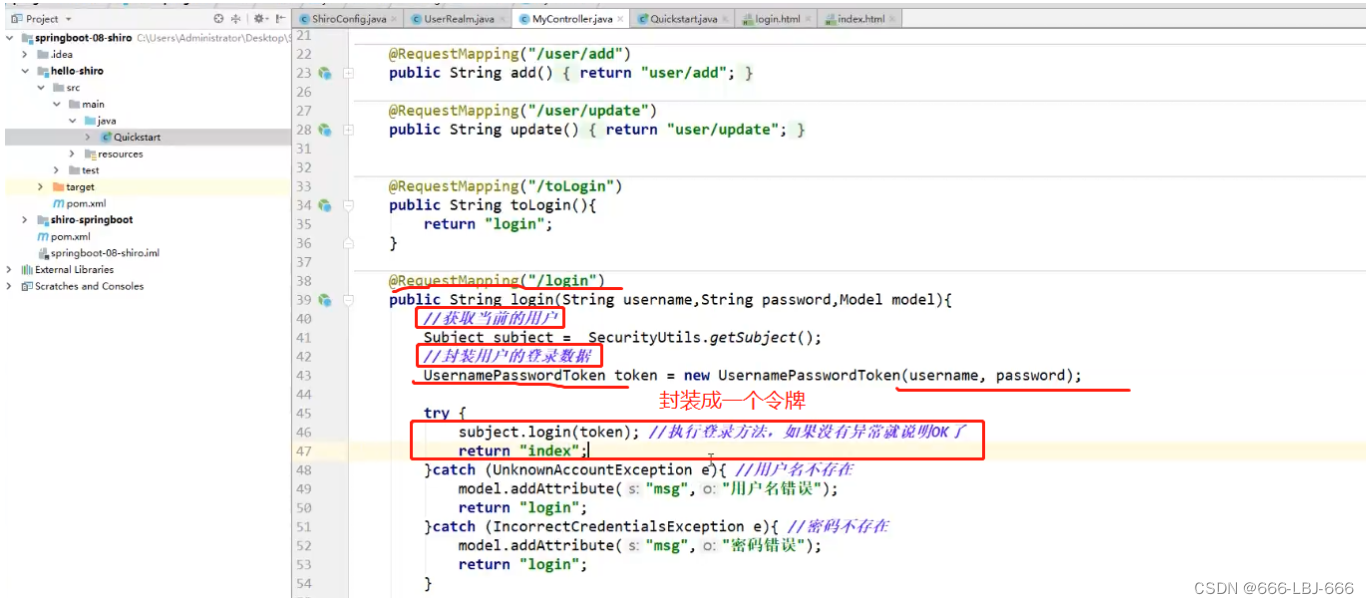
@RequestMapping("/login")
public String login(@RequestParam("username") String username,@RequestParam("password") String password,Model model) {
//获取当前的用户
Subject subject = SecurityUtils.getSubject();
//封装用户的登录数据
UsernamePasswordToken token = new UsernamePasswordToken(username, password);
try {
subject.login(token);//执行登录的方法,如果没有异常
return "index";
} catch (UnknownAccountException e) {
model.addAttribute("msg", "用户名错误");
return "login";
} catch (IncorrectCredentialsException e) {
model.addAttribute("msg", "密码错误");
return "login";
}
}
②login页面,提示信息
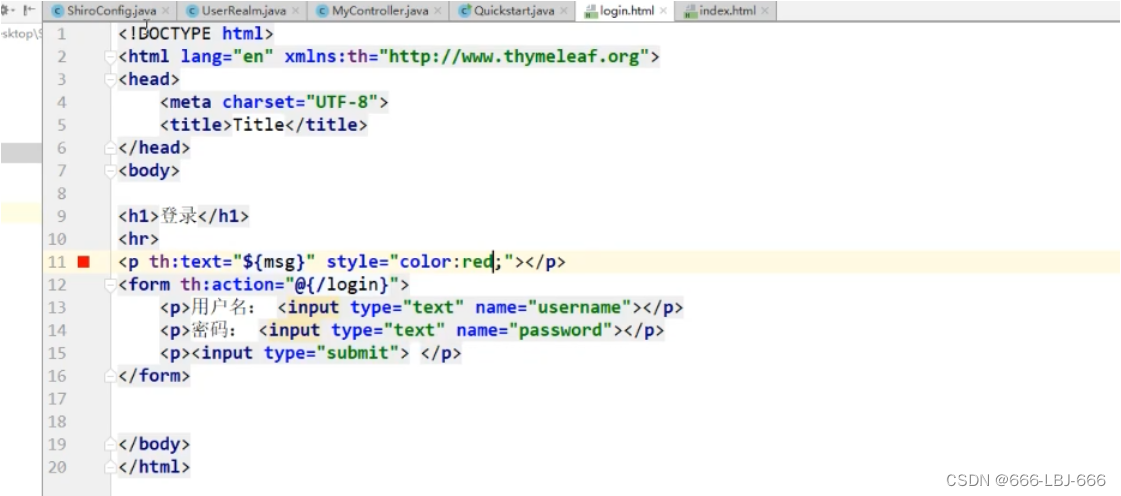
测试:会经过UserRealm的认证
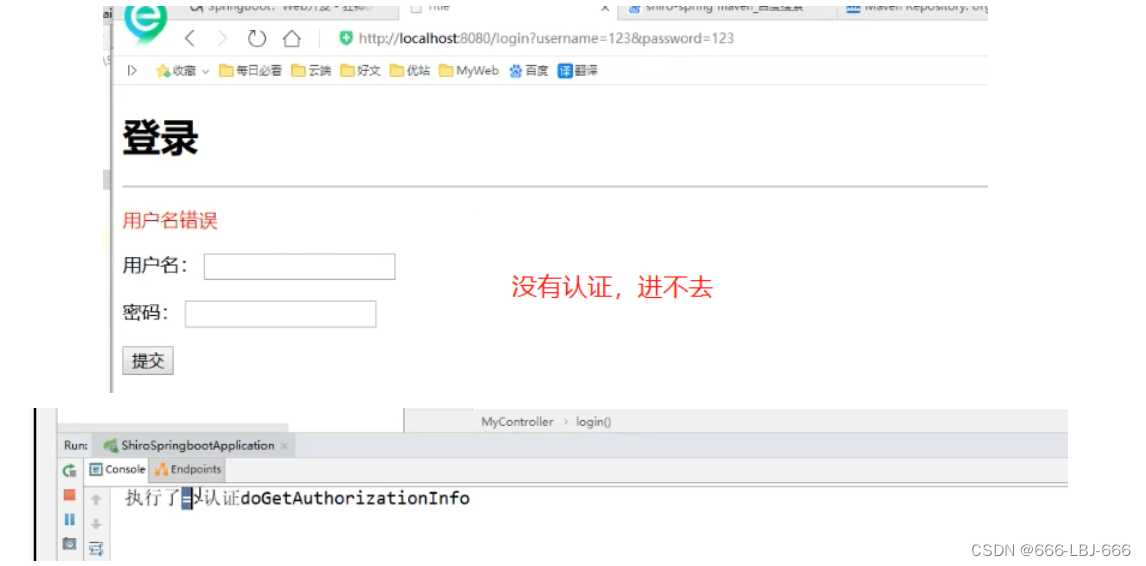
③在UserRealm中设置认证
查看源码

取出令牌中封装的数据与数据库中的数据进行比对

使用复杂参数类型的方法进行密码认证

密码认证Shiro自己做和SpringSecurity中的一样
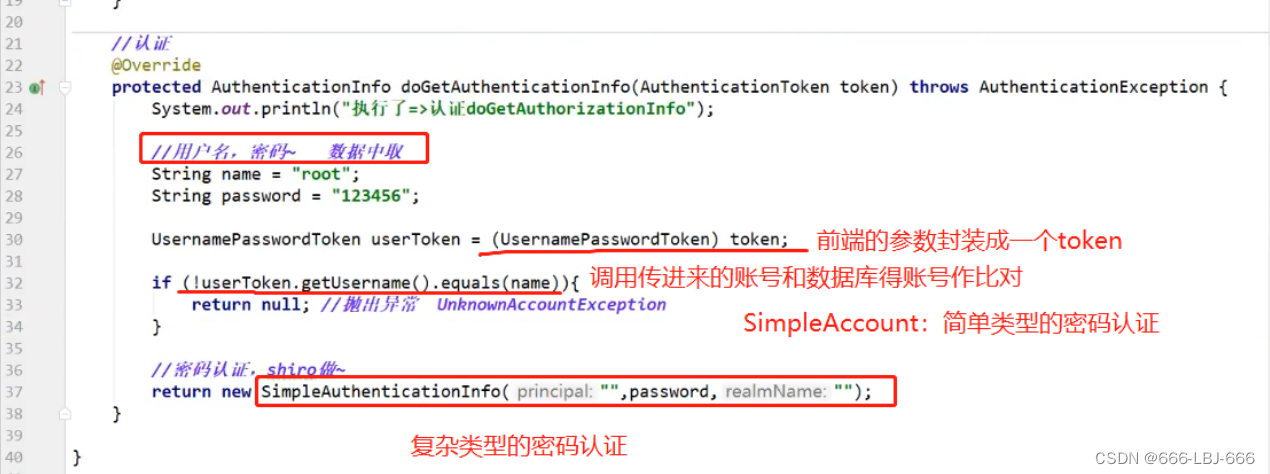
@Override
protected AuthenticationInfo doGetAuthenticationInfo(AuthenticationToken token) throws AuthenticationException {
System.out.println("执行了认证方法");
String name="root";
String password="123456";
UsernamePasswordToken userToken = (UsernamePasswordToken)token;
if(!userToken.getUsername().equals(name)){
return null;
}
return new SimpleAuthenticationInfo("",password,"");
}
测试:

不需要看上面图片的红字
4、Shiro整合Mybatis
1.首先导入需要的所有的maven依赖
①mysql-connect ②druid ③log4j ④Mybatis-spring-boot-starter
<dependency>
<groupId>org.mybatis.spring.boot</groupId>
<artifactId>mybatis-spring-boot-starter</artifactId>
<version>2.2.2</version>
</dependency>
<dependency>
<groupId>mysql</groupId>
<artifactId>mysql-connector-java</artifactId>
<version>8.0.28</version>
</dependency>
<dependency>
<groupId>com.alibaba</groupId>
<artifactId>druid</artifactId>
<version>1.2.8</version>
</dependency>
<dependency>
<groupId>log4j</groupId>
<artifactId>log4j</artifactId>
<version>1.2.17</version>
</dependency>
2.编写配置文件application.properties或者application.yaml

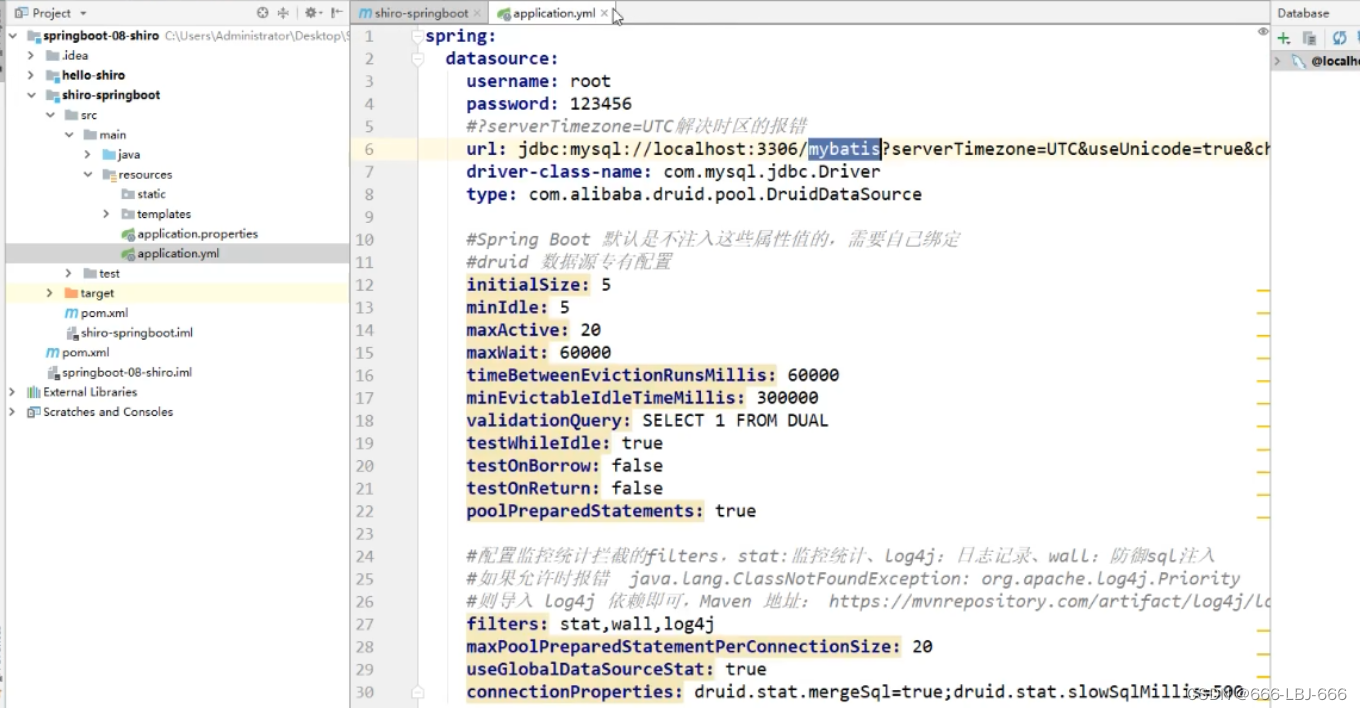
# 应用名称
spring.application.name=springboot-shiro
# 应用服务 WEB 访问端口
server.port=8081
spring:
datasource:
username: root
password: "20000215"
driver-class-name: com.mysql.cj.jdbc.Driver
url: jdbc:mysql://localhost:3306/mybatis?serverTimezone=GMT%2B8&useSSL=false&useUnicode=true&characterEncoding=UTF-8
#Spring Boot 默认是不注入这些属性值的,需要自己绑定
#druid 数据源专有配置
initialSize: 5
minIdle: 5
maxActive: 20
maxWait: 60000
timeBetweenEvictionRunsMillis: 60000
minEvictableIdleTimeMillis: 300000
validationQuery: SELECT 1 FROM DUAL
testWhileIdle: true
testOnBorrow: false
testOnReturn: false
poolPreparedStatements: true
#配置监控统计拦截的filters,stat:监控统计、log4j:日志记录、wall:防御sql注入
#如果允许时报错 java.lang.ClassNotFoundException: org.apache.log4j.Priority
#则导入 log4j 依赖即可,Maven 地址:https://mvnrepository.com/artifact/log4j/log4j
filters: stat,wall,log4j
maxPoolPreparedStatementPerConnectionSize: 20
useGlobalDataSourceStat: true
connectionProperties: druid.stat.mergeSql=true;druid.stat.slowSqlMillis=500
3、SpingMVC
①实体类
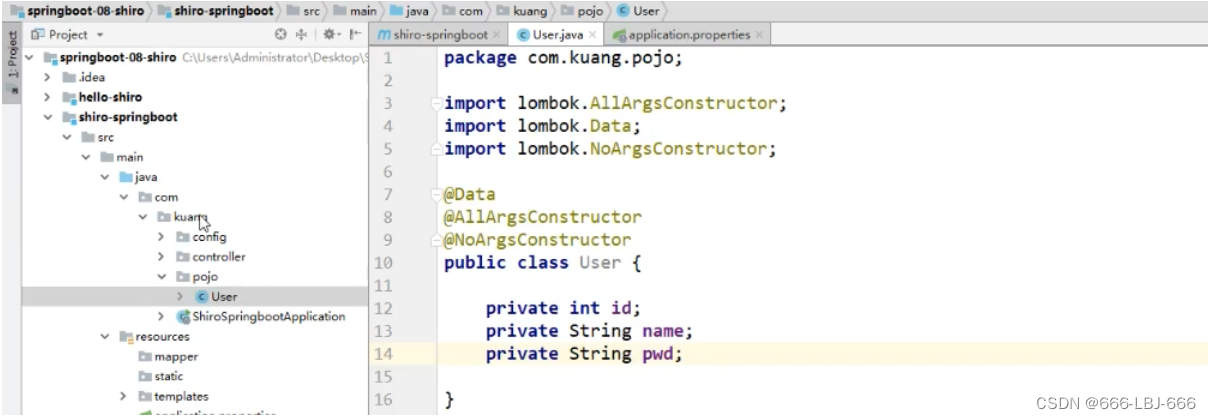
②Mapper接口
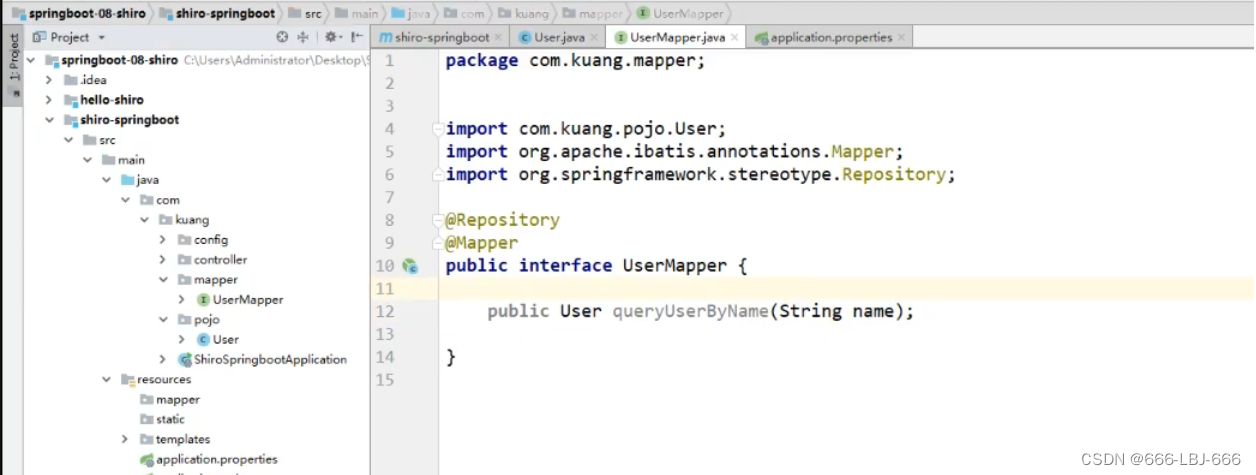
③Mapper接口对应的xml
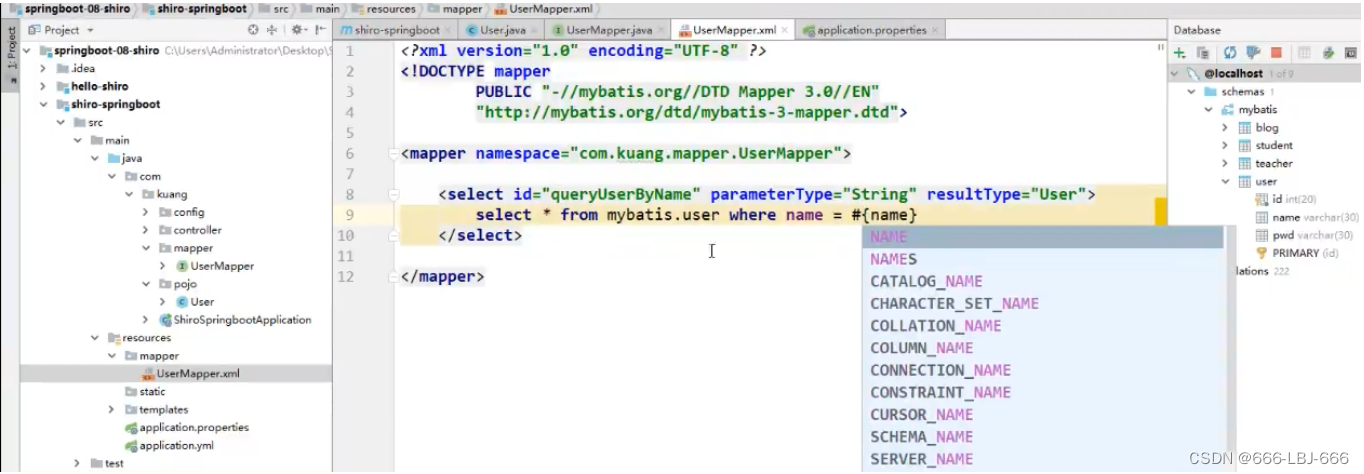
④Service层

Service的实现类
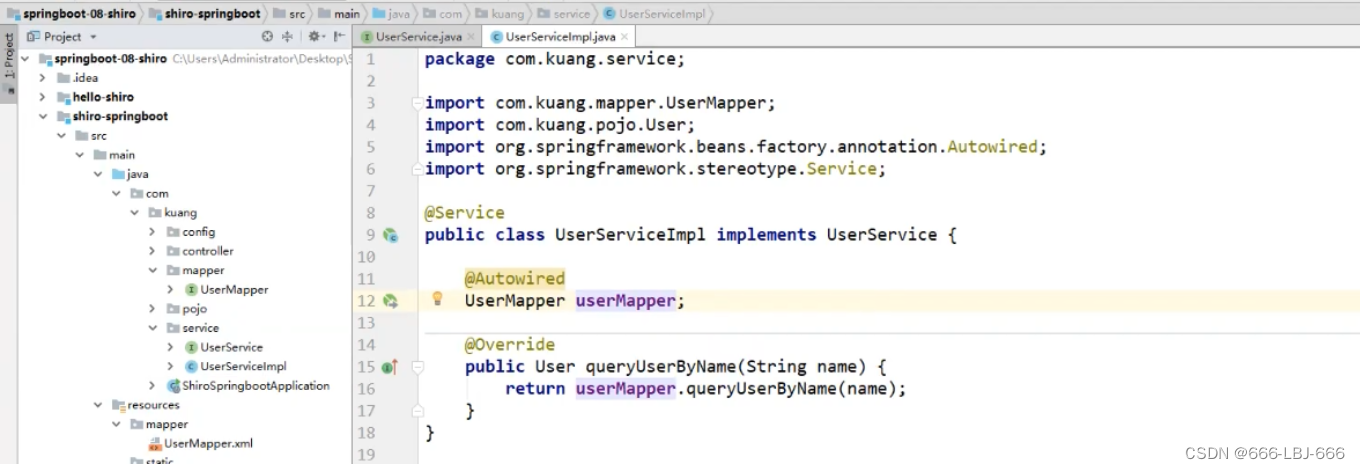
4、获取数据库数据进行认证
①设置认证
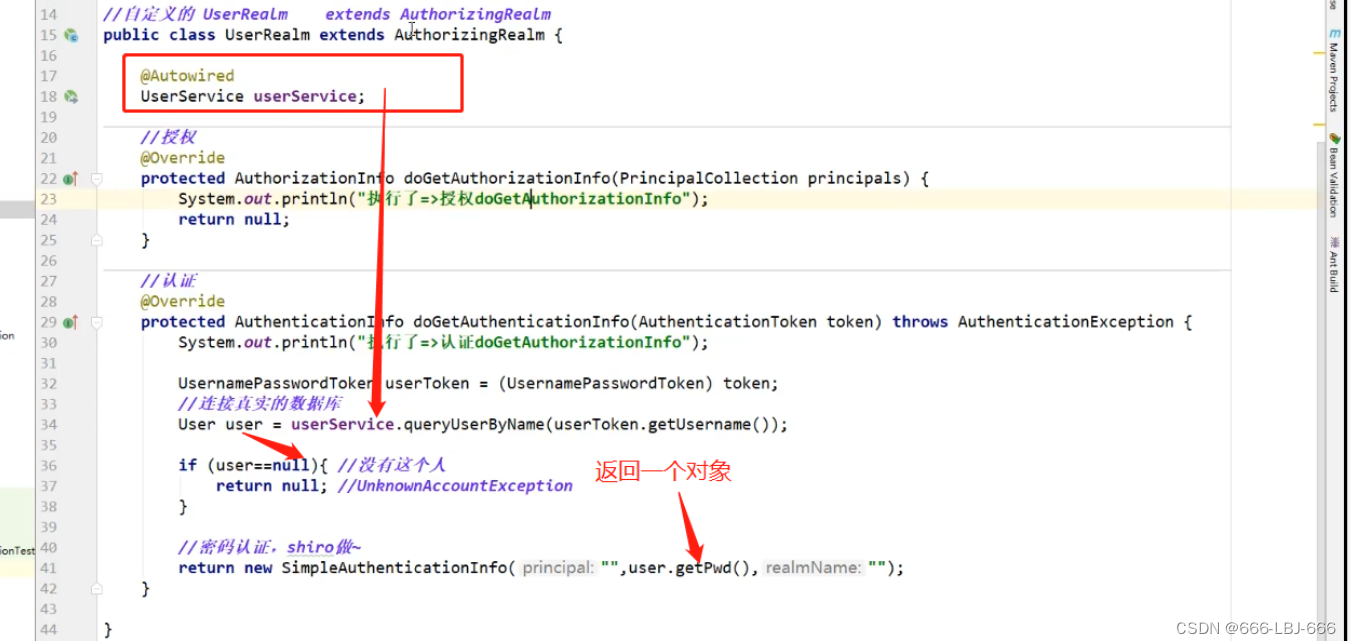
②查看加密方式

MD5加密、MD5盐值加密


默认使用SimpleCredentialsMatcher简单加密

MD5加密继承Hash加密,Hash加密继承简单加密,所以可以MD5属于自定义加密方式
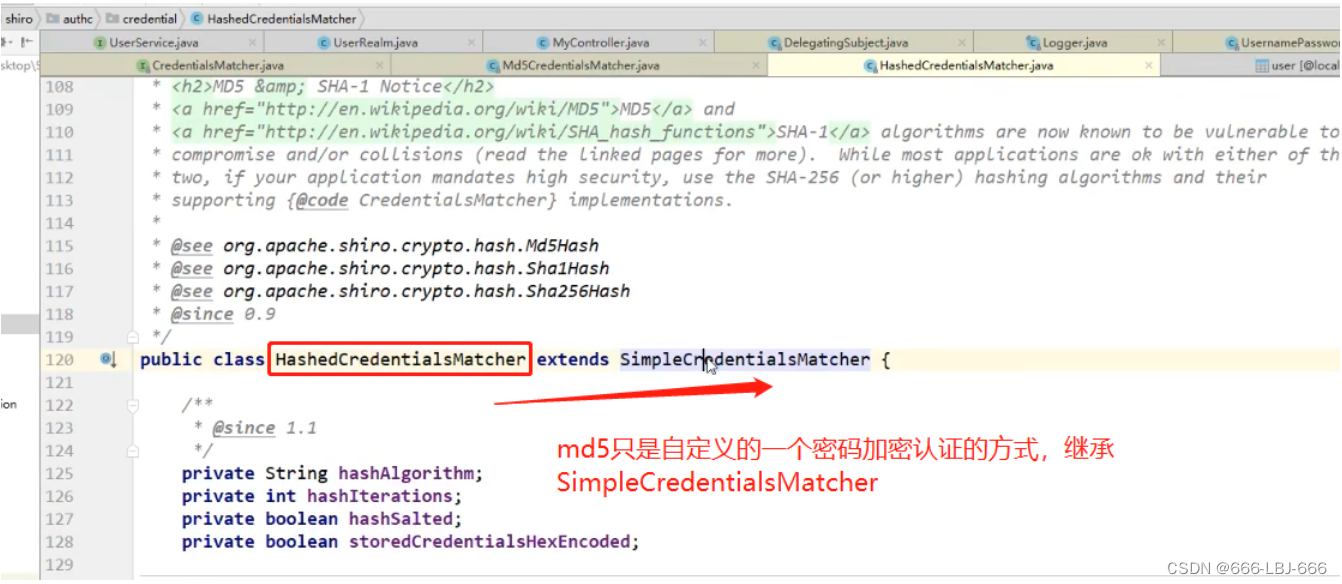
5、Shiro请求授权实现
①设置未经授权,跳转的页面

②设置授权的perms,有这个perms才可以跳转页面
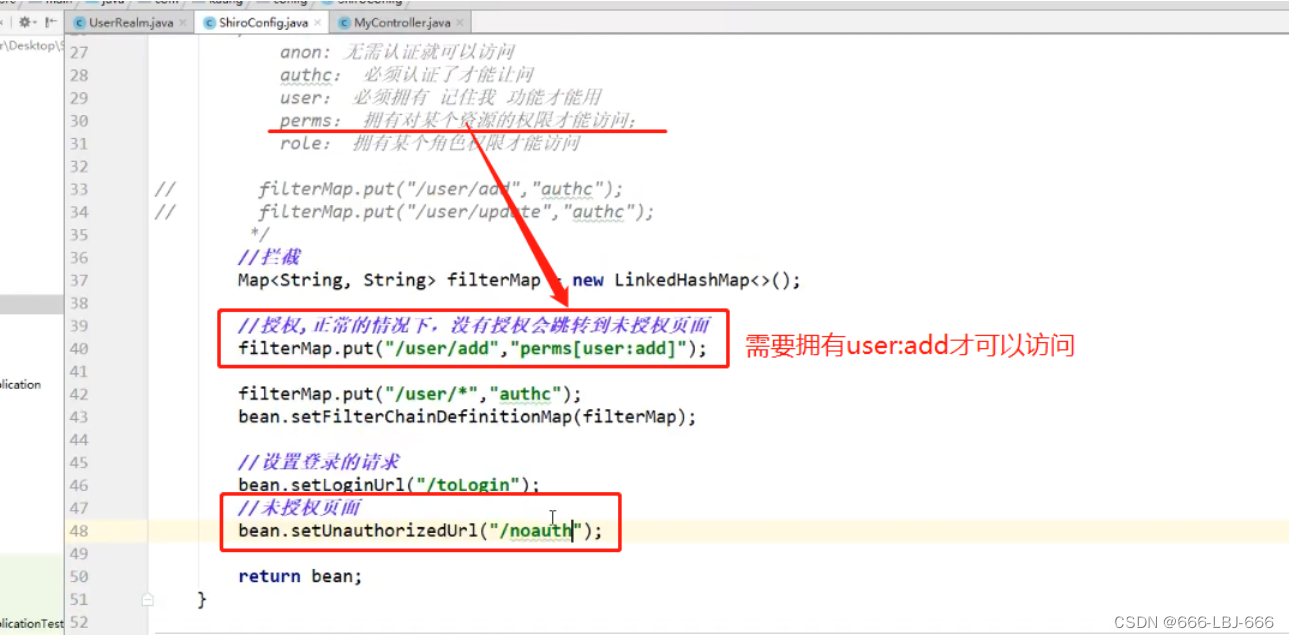
设置未授权时,跳转的页面url
测试:

③设置授权
登陆就会出现认证,跳转页面需要授权

在这个授权设置里面,需要编写授权的条件,否则写死代码,就所有用户都有授权了,还需要结合从数据库中查出信息
④新增数据库字段,设置perms

实体类对应数据库字段
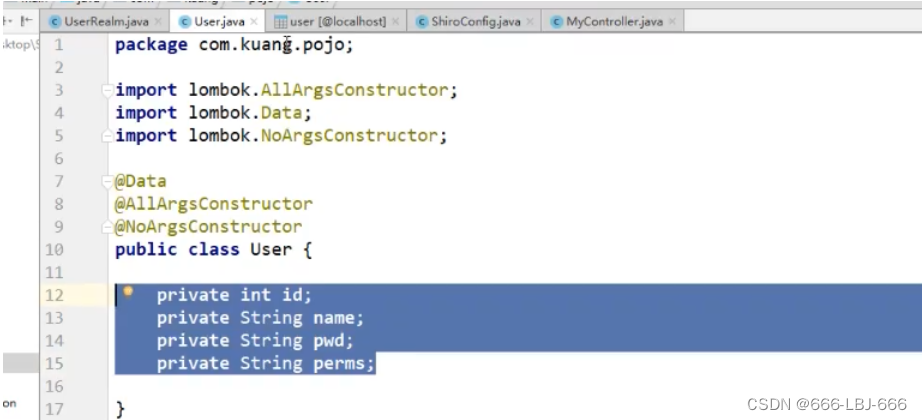
⑤修改授权
<1>想到了两个:①session ②principal:用户当前对象的属性来取get方法或(点属性)
我们在认证中,最后new了一个SimpleAuthenticationInfo的当前认证对象,之前里面要传递三个参数分别为:
(资源,密码,realmName)
需要解决:如何将 认证 中封装的对象(数据库中有这个用户情况下),传递到 授权 中,这里使用principal来保存
拿到的当前登录的对象,使用getprincipal()来获取通过认证的用户对象
<2>把获取到的user传入到资源中去。
return new SimpleAuthenticationInfo(user,user.getPwd(),"");
这样一来,user这个资源就传递到了当前用户subject整体资源中,通过当前subject获取资源来获取到这个user
<3>先获取subject当前用户
Subject subject = SecurityUtils.getSubject();
<4>然后通过subject获取到资源
User currentUser = (User) subject.getPrincipal();
<5>再给当前用户添加user中对应的权限名,注意方法名是addStringPermission权限
info.addStringPermission(currentUser.getPerms());
<6>最后返回当前权限info
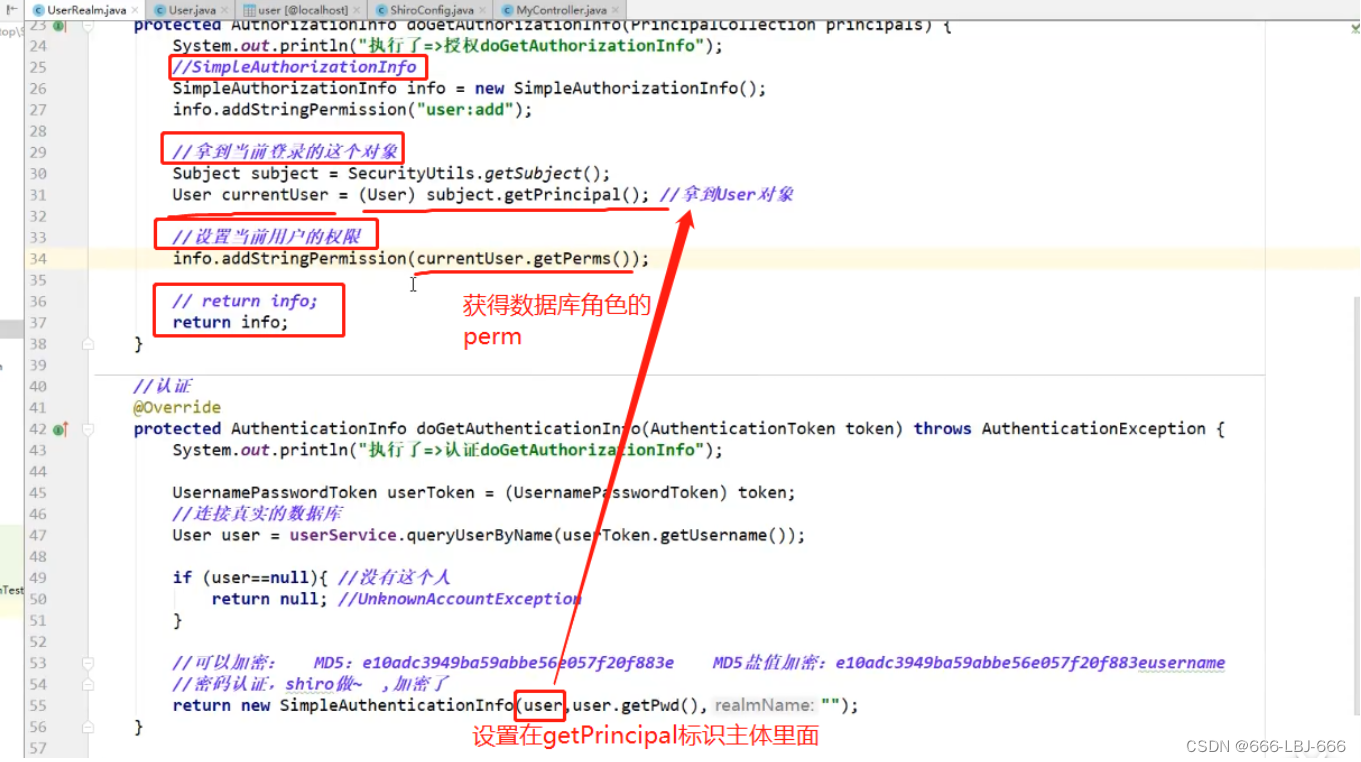
注:根据数据库中查出来的具体的perms,设置当前用户的permission,当用户请求url通过过滤器的时候,这个当前用户的perms会和过滤器中规定的授权的perms比较,如果一样,就可以授权,如果不一样,就处于未授权状态
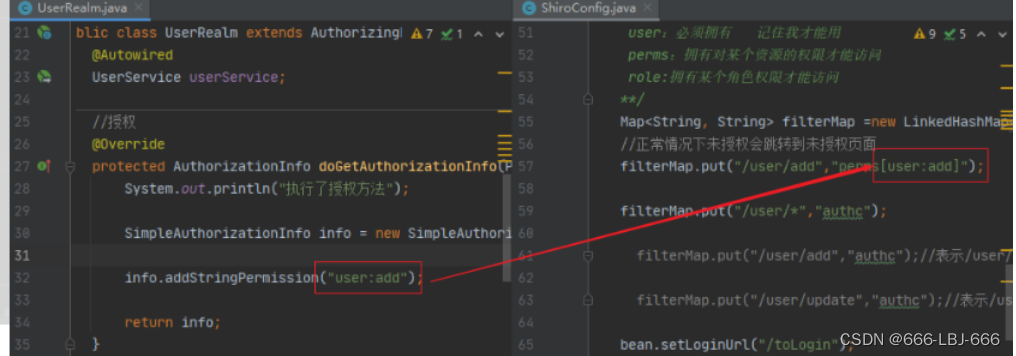

//授权
@Override
protected AuthorizationInfo doGetAuthorizationInfo(PrincipalCollection principalCollection) {
System.out.println("执行了授权方法");
SimpleAuthorizationInfo info = new SimpleAuthorizationInfo();
Subject subject = SecurityUtils.getSubject();
User currentUser = (User) subject.getPrincipal();
//设置当前用户的权限
info.addStringPermission(currentUser.getPerms());
return info;
}
退出功能就和之前security的logout一样,设置一下退出的路径就可
好现在基本需求都完了,但是想和之前security一样实现没有权限的就不要显示,就需要和thymeleaf结合
6、Shiro整合Thymeleaf
①首先要导入Shiro和thymeleaf结合的依赖
<!-- https://mvnrepository.com/artifact/com.github.theborakompanioni/thymeleaf-extras-shiro -->
<dependency>
<groupId>com.github.theborakompanioni</groupId>
<artifactId>thymeleaf-extras-shiro</artifactId>
<version>2.0.0</version>
</dependency>
②先整合shiro和thymeleaf
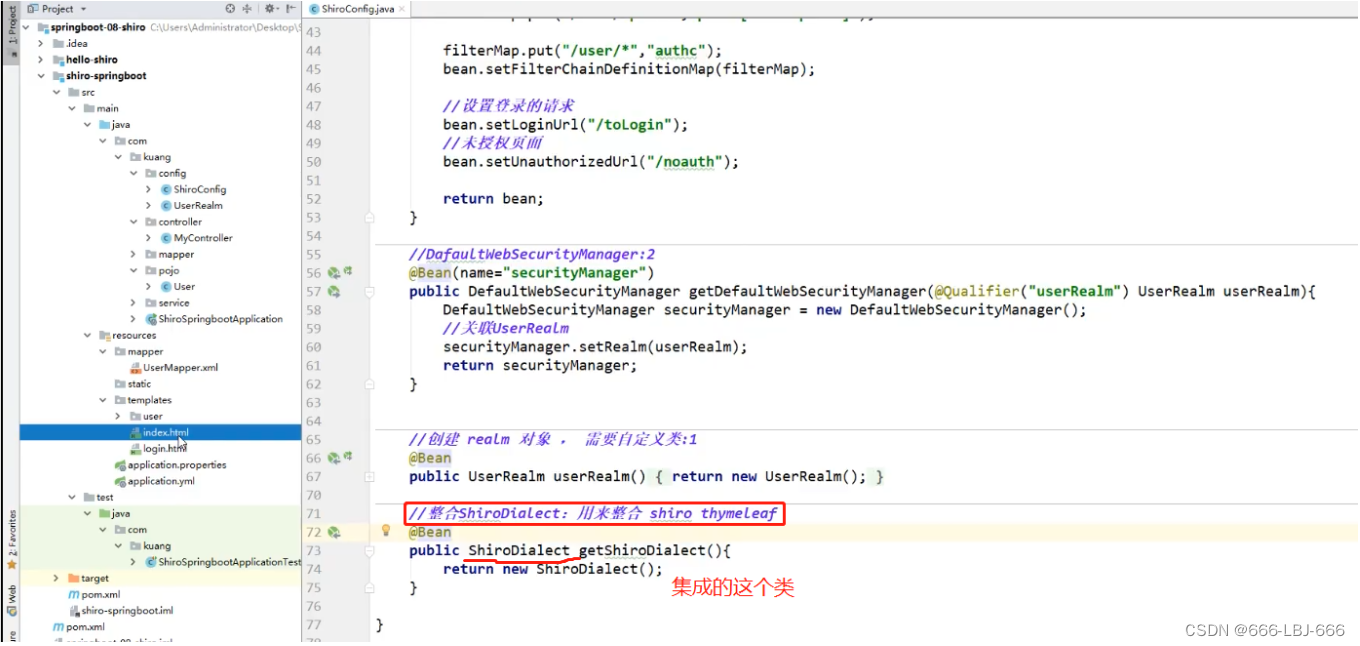
③设置命名空间,才可以使用专属标签
下面是spring-security的命名空间
xmlns:sec="http://www.thymeleaf.org/thymeleaf-extras-springsecurity5"
shiro的:
xmlns:shiro="http://www.thymeleaf.org/thymeleaf-extras-shiro"
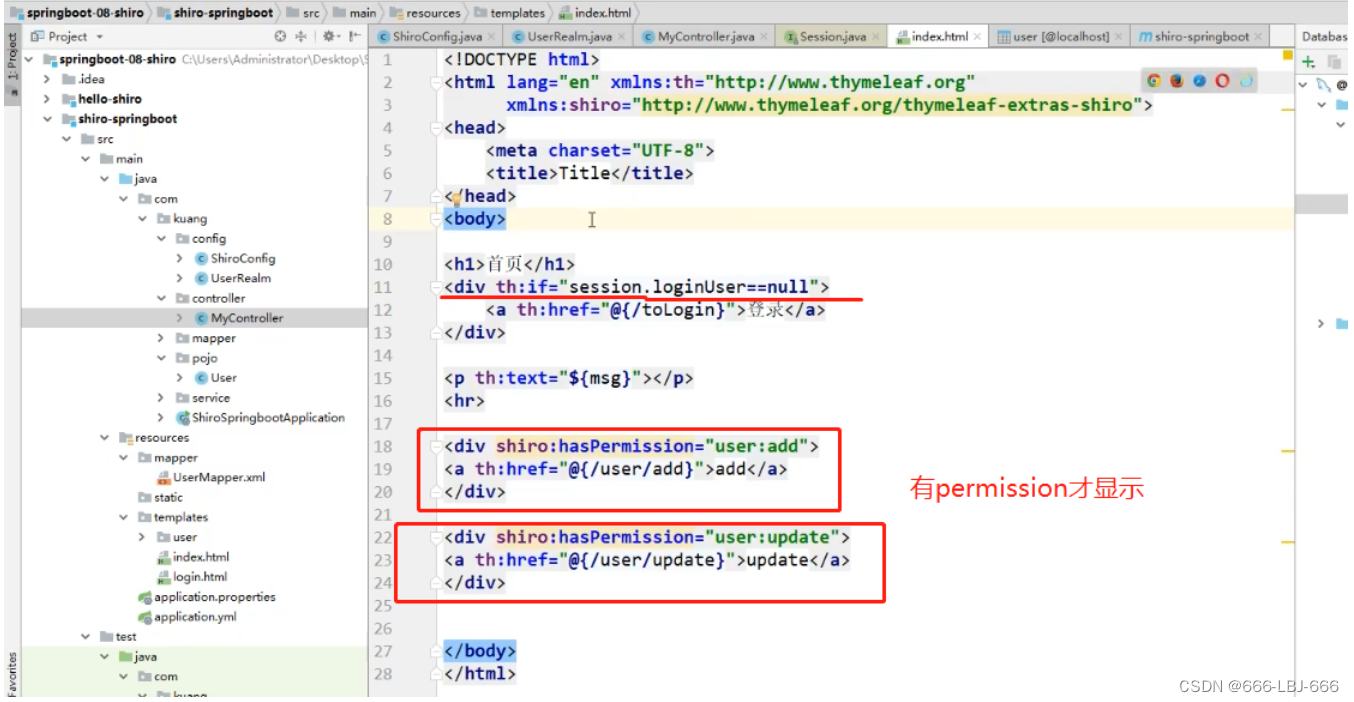
前端代码:
<p th:text="${msg}"></p>
<hr>
<a><a th:href="@{/toLogin}">登录</a>
<div shiro:hasPermission="user:add">
<a th:href="@{/user/add}">add</a>
</div>
<div shiro:hasPermission="user:update">
<a th:href="@{/user/update}">update</a>
</div>
④登录按钮,登录后不显示,未登录显示
<1>方式1(未实现):可以通过设置session中的用户对象,来判断。
如下面:
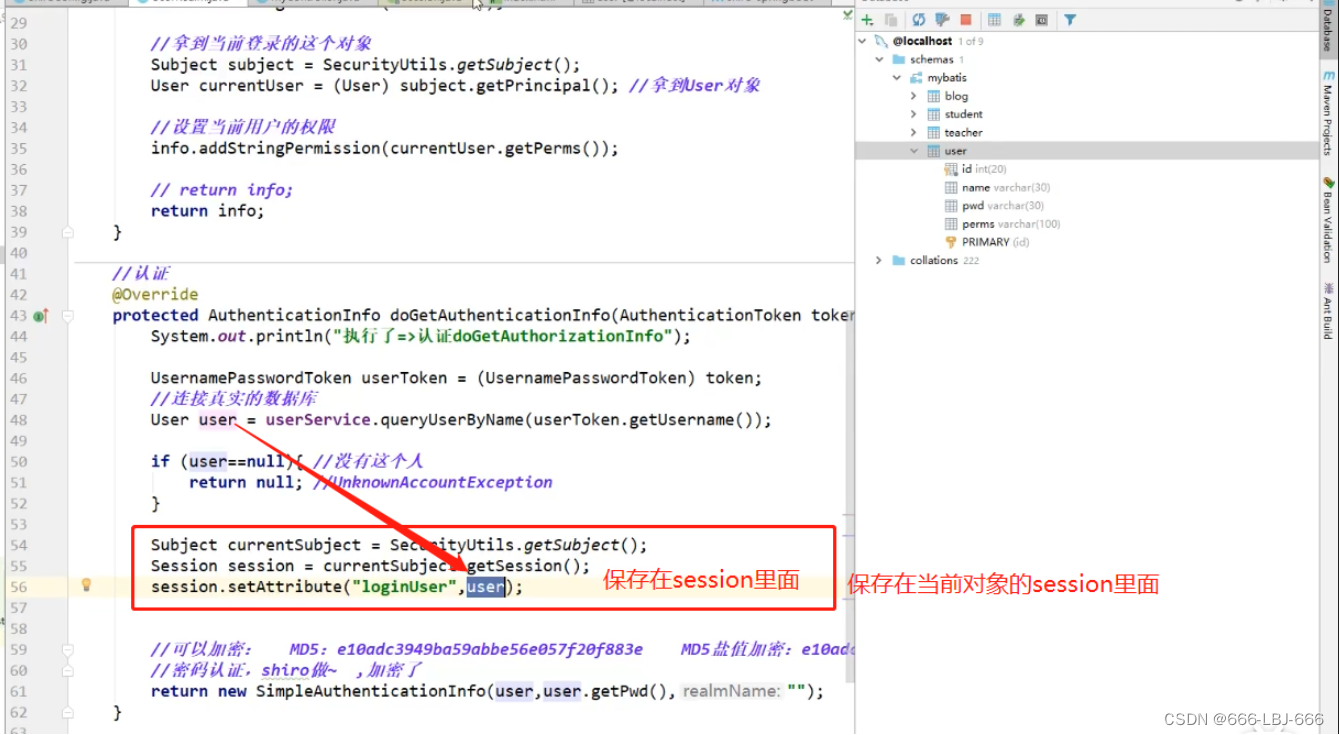
注:session对象是在浏览器中保存的,在dispatchservlet和controller之上的
<2>方式2(已实现):只要判断授不授权就可以控制显示
解释一下就是判断一下当前的用户是否有当前的权限,如果有则显示,没有不显示
登录按钮无权限时显示:
<div shiro:notAuthenticated>
<a th:href="@{/toLogin}">登录</a>
</div>
测试:
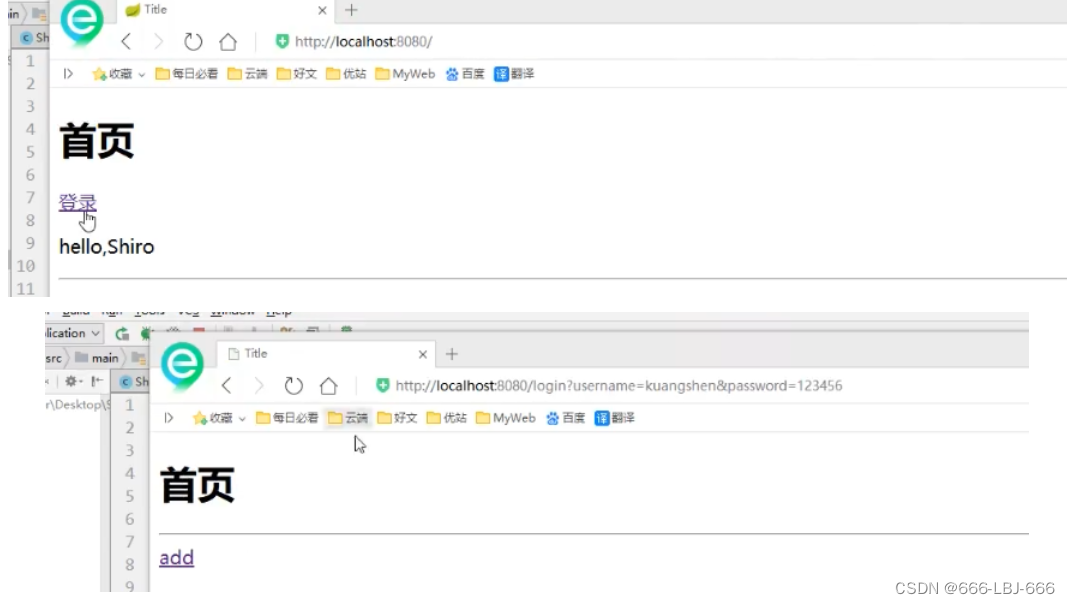
SpringBoot学习(六)-SpringBoot整合Shiro 开发的学习笔记到此完结,笔者归纳、创作不易,大佬们给个3连再起飞吧










